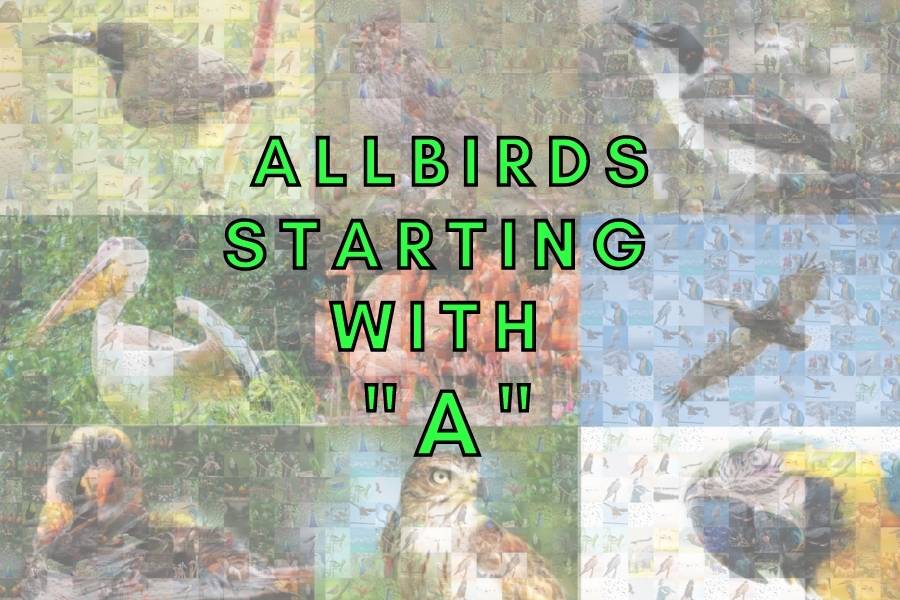There are so many different types of birds in the world, with many different names(!), and it can be tough to keep track of all of them. If you’re looking for a specific type of bird, one way to narrow down your search is to look for birds that start with a certain letter.
There are more than 400 bird species starting with the letter A! From the Abbots Babbler and the American Goldfinch to the Australian Lincoln Ringneck!
In this blog post, we’ll be focusing on birds that start with the letter A. We’ll provide a list of bird names along with brief descriptions to help you get an idea of where they live and how they look.
At the end of this post (scroll or use the table of content to get there!), I have put a list with all names sorted after length to make it easy for you to find the bird names starting with an A that are 5, 6, 7, 8,9, 10 letters long and up to 36 letters for the longest bird name starting with A!
In the first table shown below, are some examples of birds named after their location of origin, such as “African”, “Australian” or “American”, and you can read about all of them here!
| Birds starting with “African” | Birds Starting with “American” | Birds starting with “Australian” |
| African Barred Owlet | American Avocet | Australian Brush-turkey |
| African Baza | American Bittern | Australian Bustard |
| African Black Duck | American Black Duck | Australian Crake |
| African Black-headed Oriole | American Coot | Australian Darter |
| African Blue Tit | American Crow | Australian Hobby |
| African Blue-Flycatcher | American Dipper | Australian Ibis |
| African Broadbill | American Golden-Plover | Australian King-Parrot |
| African Bush-Warbler | American Goldfinch | Australian Koel |
| African Citril | American Harrier or Marsh Hawk | Australian Magpie |
| African Collared-Dove | American Kestrel | Australian Masked-Owl or Masked Owl |
| African Crake | American Mountain Thrush | Australian or Nankeen Kestrel |
| African Crested-Flycatcher | American Oystercatcher | Australian or Port Lincoln Ringneck |
| African Cuckoo | American Painted-snipe | Australian Owlet-Nightjar |
| African Darter | American Pipit or Buff-bellied Pipit | Australian Pelican |
| African Dusky Flycatcher | American Pygmy Kingfisher | Australian Pratincole |
| African Emerald Cuckoo | American Redstart | Australian Raven |
| African Finfoot | American Robin | Australian Reed-Warbler |
| African Firefinch | American Three-toed Woodpecker | Australian Shelduck |
| African Fish-Eagle | American Tree Sparrow | Australian Shoveler |
| African Forest-Flycatcher | American White Pelican | Australian Swiftlet |
| African Golden-breasted Bunting | American Wigeon | Australian Yellow White-eye |
Descriptions of all birds beginning with an A:
Below I have written a short description of all birds in the world with a name that starts with the letter A, but I have also written about all birds starting with the letter E, birds named with K as their first letter and also birds with the initial letter F and those birds beginning with G.
Abbott’s Babbler

This babbler is found in tropical Africa, mainly in Guinea and Liberia, and can also be found at central and western Africa.
Abbott’s Booby
It is a large seabird, with a dark, fluffy body, and a grey head. This species is diurnal, and is non-migratory.
Abbott’s Starling
It is a resident bird of South Asia. It is fairly common in parks and gardens, although it is sometimes lured into captivity and released.
Abdim’s Stork

This stork is a large, long-legged bird. It is widespread in Africa, as well as the Indian subcontinent. It spends most of its life wading in marshes or lakes, searching for food. It usually nests in colonies on lakes, where its nest looks like a large, floating raft.
Aberdare Cisticola
This cicada is endemic to the Aberdares in Kenya. The Aberdares Cisticola feeds on nectar, insects, spiders, and seeds.
Aberrant Bush-Warbler
This bird is a species of bush-warbler endemic to the Aberdare Mountains of Kenya.
Abert’s Towhee

This towhee is found in eastern, southern and central Africa. It breeds from southern Ethiopia to Zambia, and southeast to Angola. It spends the dry season in southern Africa.
Abyssinian Catbird
This medium-sized catbird is endemic to the island of Madagascar. This species of catbird is the most common species of towhee in the drier parts of its range.
Abyssinian Crimson-wing
It is a species of bird in the family Icteridae found in Madagascar and in eastern Africa.
Abyssinian Grosbeak-Canary
This seedeater is endemic to the island of Madagascar.
Abyssinian Ground-Thrush
Garrulax abyssinicus is a medium-sized ground-dwelling thrush. It breeds in north-east Africa and Arabia and takes “molt” (shed old feathers, and grow new ones) in the Ethiopian highlands. It prefers dry open country, usually near water. In migration, it passes through upland tropical grasslands.

The abyssinian ground-thrush feeds on the ground in savannahs and open woodland. It feeds mainly on insects, but will also take berries. The nest is an underground tunnel in loose soil. The males sings two simple, monotonous, ascending notes which are easier to hear than the normal song.
Abyssinian Hill-Babbler
The Abyssinian Hill-babbler is a passerine bird in the Timaliidae family. It is found in Ethiopia and Somalia. Its natural habitat is subtropical or tropical dry montanes, dry savanna, subtropical or tropical high-altitude shrubland, and arable land. It is threatened by habitat loss.
Abyssinian Lark
The Abyssinian lark is a small, terrestrial passerine bird which builds a nest on the ground in dry, dense, thorny, and rocky areas. This lark is resident in the Ethiopian highlands. The Abyssinian lark is not closely related to other larks, but formerly was considered a member of the Alaudidae family.
Abyssinian Longclaw
The Abyssinian Longclaw (Macronyx abyssinicus) is a species of bird in the Furnariidae family. It is found in Ethiopia.
Abyssinian Owl
The Abyssinian owl is a resident breeding bird in south-east Ethiopia and north-east Somalia. It is found mainly in southern Somalia. It lives in the lowland forest and savannah belt, and is most common up to an altitude of 4000 meters.

The Abyssinian owl feeds on small mammals and birds. It hunts during the daytime. It nests in a hole in a tree trunk. The bird is polytypic.
Abyssinian Roller
The Abyssinian Roller is a large bird of prey from the African savannas. Its long, broad wings and tail give it excellent gliding capability. Its plumage is almost all-black, apart from a white stripe through the eyes, and a white patch at the base of most of the flight and tail feathers.
Abyssinian Scimitar-bill
The Abyssinian Scimitar-bill is a medium-sized tyrant flycatcher. This is a “typical” species in morphology although its small size and desert distribution are unusual.
Abyssinian Siskin
The Abyssinian Siskin is a passerine bird in the finch family Fringillidae. It is resident in montane forests in central and eastern Africa south of the Saharan zone. It feeds on insects from bushes and trees. It is 13–15 cm long and weighs 12–16 g.
Abyssinian Slaty-Flycatcher
The Abyssinian Slaty-Flycatcher is a species of bird in the tyrant flycatcher family.
It occurs in south-eastern Ethiopia, southern Somalia, western Kenya and south-western Tanzania.
Abyssinian Waxbill
The Abyssinian Waxbill is a very small passerine bird which breeds in east and central Africa. It is partially migratory, with 4-5% of the population moving to other areas during the non-breeding season. Like other waxbills, it is metallic green overall with a black cap, red throat, and yellowish underparts.
Abyssinian Woodpecker
The Abyssinian Woodpecker is a species of bird in the family Picidae. It is found in Ethiopia, Kenya, Somalia, South Sudan, Tanzania and Uganda. Its natural habitat is moist savanna.
Abyssinian Yellow-rumped Seedeater
The Abyssinian Yellow-rumped Seedeater is a bird in the Thraupidae family.
Acadian Flycatcher
The Acadian Flycatcher is a species of bird in the tyrant flycatcher family.
Acorn Woodpecker
The Acorn Woodpecker is a medium-sized, stocky woodpecker. The male has a red cap, red forehead, black and white collar and a white moustache in front.
The white line on the head and the black bib below the white throat patch contrast sharply with the sandy brown upperparts, rump and tail. The white wings have brown flight feathers and the dark tail feathers have white tips. The bill is usually yellowish, and the legs are greenish-brown.
Adalbert’s Eagle
The Adalbert’s Eagle is a large bird of prey found in sub-Saharan Africa, with a preference for tropical rainforest. It preys mainly upon monkeys and large birds, but also takes reptiles and occasionally bats and small mammals.

The nest is a tree hole, usually in a tree such as the Sausage Tree. The female lays one white egg and both parents incubate it.
Adamawa Turtle-Dove
The Adamawa Turtle-Dove is a large dove, 32 to 37 cm in length. It is mainly pale brown on the head, neck and underparts, with dark brown upperparts and a brown-white-barred belly. The head has a grey-brown brow and a blackish patch above the white eye. It has pale, pale yellow legs and dark eyes. The calls are a large number of coos and bubbling notes, as well as a low, hollow, cooing whistle.
Adelaide’s Warbler
Adelaide’s Warbler is a medium-sized warbler found in Australia, where it inhabits open forests and woodlands. It has a white front, black upperparts, and olive brown underparts. The female has greyish-brown cheeks and throat while the male has a grey throat. The male has white wingbars and a black stripe on its breast. It is fairly common.
Adelie Penguin
The Adelie Penguin is a large black and white crested penguin, found in the Antarctic. It often nests at penguin colonies and on offshore islands. The Adelie penguin is as its name suggest, the most common penguin found over the Antarctic. The Adelie penguin lays one egg and both parents care for it.
Afep Pigeon
The Afep Pigeon is a medium-sized pigeon endemic to Eastern Africa. It is fairly widespread in Africa, ranging from Senegal, the Gambia and Guinea-Bissau in the west, to Sudan. The range of the Afep pigeon extends further east through Eritrea, Ethiopia, Somalia, Kenya, Uganda, Djibouti and east to Tanzania. The Afep pigeon feeds on seed, fruit and insects.
Afghan Snowfinch
The male has a white head with black whisker and eye line, black upperparts and face, a rufous streak on the rump, breast, and flanks, white underparts and a short white tail band. The female has grey upperparts and white underparts. The juvenile resembles the female, but with brown suffusion on the breast and flanks.
African Barred Owlet
As its name suggests, the African Barred Owlet is endemic to southern Africa and differs from other owlets in having a broad facial disc, reddish-brown crown and nape, and calls for a noisy hooting (DuPlessis and Hockey, 1977).
African Baza
The African Baza is a near-passerine bird with a rather short tail and long wings.
African Black Duck
African Black-headed Oriole
The African Black-headed Oriole is a large, black-headed oriole. The plumage of this large oriole is mainly black above, with turquoise-blue upper tail-coverts and a short crest, and a white belly. The face is black with a turquoise-blue supercilium, yellow iris, and white lower mandible.
African Blue Tit
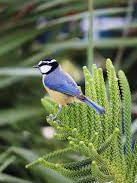
The Blue Tit is a small passerine bird which is a common and widespread summer visitor to the United Kingdom, its territories in mainland Europe and Asia.
African Blue-Flycatcher
The African blue flycatcher is a flycatcher found in West Africa, where it inhabits forest and woodland. It feeds on a wide range of insects, but is known to also take small vertebrates such as lizards.
African Broadbill
The African Broadbill, Smithornis capensis, is a large passerine bird with a predominantly black bill. It ranges from the Horn of Africa and Arabia east to southern India and Sri Lanka, south to northern and eastern South Africa, and south to Mozambique. They feed on fruits, berries and nectar of tropical and subtropical trees and shrubs.
African Bush-Warbler
The African Bush-Warbler, Bradornis baboecala, is a highly distinctive warbler, a member of the family Locustellidae, containing many species commonly called ‘sedge warblers’.
African Citril
The single species of Citril, Citril cristata, is a passerine bird, recently discovered in 1996 in the rainforests of Equatorial Guinea. It is considered to be one of the 20 most threatened bird species in the world.
African Collared-Dove
The African Collared-Dove, Streptopelia roseogrisea, is a dove which is widespread south of the Sahara Desert. It is paler below than Streptopelia semitorquata, but has a distinctive black collar.
African Crake
The African Crake, Crex egregia, is a water bird in the rail, crakes and coot family. It ranges throughout both Africa south of the Sahara, and through Europe and Asia to the Middle East and has been introduced New Zealand. Its numbers have declined over most of its range due to habitat loss and disturbance.
African Crested-Flycatcher
The African Crested-Flycatcher, Pseudocolopteryx coronata, is a passerine bird in the Old World flycatcher family. It is found mainly in sub-Saharan West Africa.
African Cuckoo
The Cuckoo is an Old World bird in the Cuculidae family. Although the Cuculidae family contains cuckoos, they are not related to the typical cuckoos. But at least thirteen species are now separated as placed in the genus Hierococcyx. Several of these species are known as Asian cuckoos.
African Darter
The African Darter is a widespread but uncommon African wader, in length. Both sexes are similar, with slate-grey body plumage, pale underparts, and a heavily streaked reddish-brown back. The face and underwing are white.
The legs are greenish and the eyes are dark; the bill is blackish. This wader’s flight is slow and undulating, often in stooped positions. It tends to idle in shallow water, where it feeds. Virtually nothing is known about migratory patterns of the African Darter.
African Dusky Flycatcher
The African Dusky Flycatcher is a passerine bird in the Old World flycatcher family Muscicapidae. It is a resident breeder in tropical western and central Africa.
The African Dusky Flycatcher is evaluated as Least Concern on the IUCN Red List of Threatened Species.
It is an uncommon species with a wide range, and hence does not approach the thresholds for Vulnerable under the range size criterion (Extent of Occurrence <20,000 km2 combined with a declining or fluctuating range size, habitat extent/quality, or population size and a small number of locations or severe fragmentation).
The population trend appears to be stable. The species is not believed to approach the thresholds for Vulnerable under the population trend criterion (>30% decline over ten years or three generations).
African Emerald Cuckoo
The African Emerald Cuckoo is a medium-sized bird in the cuckoo family Cuculidae, found in Madagascar, mainland Africa and Arabia. The sexes are similar in plumage, distinguished by the male’s black, collared head. The female is smaller, with a brown head and no collar. The female has a dark throat while the male has a yellow throat.
African Finfoot
The African Finfoot is an African waterbird in the rail family Rallidae. It occurs in dense reed beds of rivers in West Africa. It feeds by probing in the mud, often dabbling.
African Firefinch
The African firefinch, Erythrina caffra, is a species of bird in the family Estrildidae. This species is resident in Angola, Benin, Botswana, Burundi, Cameroon, Central African Republic, Chad, Republic of the Congo, Democratic Republic of the Congo, Ivory Coast, Equatorial Guinea, Gabon, Gambia, Ghana, Guinea, Guinea-Bissau, Kenya, Lesotho, Liberia, Malawi, Mali, Mauritania, Mozambique, Namibia, Niger, Nigeria, Rwanda, Senegal, Sierra Leone, Somalia, South Africa, South Sudan, Swaziland, Tanzania, Togo, Uganda, Zambia, and Zimbabwe.
African Fish-Eagle
The fish-eagle (Haliaeetus vocifer) is a large eagle. Its length is 1.7 m (5 ft 7 in) with a 2.3 m (7 ft 7 in) wingspan and it weighs from 2.2 to 4.9 kg (4.6 to 10 lb). It is mostly dark brown-grey, with a white belly and underwing coverts. The beak and cere are light-coloured, although this is less obvious in juveniles, which have a dark brown body plumage.
African Forest-Flycatcher
The African Forest-Flycatcher (Muscicapa appendiculata) is a near passerine bird. It is one of the smaller forest flycatchers. It is 11–15 cm long. The sexes are similar, with males being slightly larger than females. Males are olive brown above and pale brown below. Females are darker brown above and barred below. It has fairly long, slender wings with brown-black flight feathers and a white wing bar. The tail is brown. The bill is black and the eyes reddish brown.
African Golden-Oriole
The African Golden-Ladies’-Tresses (Microscepella senaia) is an African passerine bird. It is a member of the orioles and is a resident breeder in tropical Africa south of the Sahara. Its breeding habitat is canopies of forests and forest edges, from near sea level up to 2300 metres.
African Golden-Weaver
The African Golden-Weaver (Ploceus aureus), is a bird of prey in the family Ploceidae, which also includes eagles, hawks, Old World vultures, kites, harriers and Old World sparrows. It is native to the tropical and subtropical areas of Africa and was introduced to Hawaii in 1962.
African Golden-breasted Bunting
The African Golden-breasted Bunting (Emberiza flaviventris) is a passerine bird, part of the bunting family Emberizidae. The male is dark brown with white edges to the feathers, with a black face and a white throat and breast. The female is greyish brown, becoming rufous on the breast, and is dull brown on the underside.
African Goshawk
The African goshawk (Accipiter tachiro) is a large, widespread bird of prey. It is sometimes known as the Augur Buzzard. It has a wide range of habitat preferences, including wet and dry savanna, dry scrublands, and dense forests.
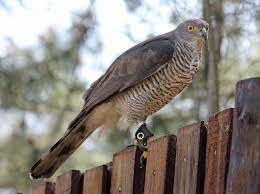
It often hunts from an exposed perch high in a tree and chases its prey; when it finally brings it down, it commonly kills it with a single blow. It hunts other birds, small mammals, and reptiles.
African Grass-Owl
The African Grass Owl is a nocturnal species of owl. It is widely distributed across central, southern Africa, from Senegal to South Africa and Mozambique to Tanzania. It belongs to the genus Tyto. The species is monotypic, and it is the only species in the genus Tyto. The species’ common name and Latin name both derive from the tuft of hairs on the throat, which distinguishes it from the related burrowing owl.
African Green-Pigeon
The African green pigeon or Angola pigeon is a type of green pigeon. There are four currently recognised subspecies found in sub-Saharan Africa:
In West Africa: The Chopi green pigeon, Treron olax (Linnaeus, 1766), also known as the chopi or chopi-dok.
In Central Africa: The Congo green pigeon, Treron veraepacis (Temminck, 1820), also known as the kob, or mele.
in East Africa: The Usambara green pigeon, Treron calvus (Temminck, 1825), also known as the kufuku.
In Southern Africa: The Zululand green pigeon, Treron pygmeus (Vieillot, 1817), also known as the umse.
African Hornbill
The African hornbill is a very large ground-dwelling bird. They are present in all tropical and most subtropical forests, woodlands and coastal forests in Africa. They are commonly found on the ground foraging for fruit, invertebrates, lizards, snakes and small mammals.
African Harrier-Hawk
The African harrier-hawk is a stocky hawk with large and much flattened feet that are partially webbed. They have short and narrow wings, a shorter tail, and a relatively small head. Adult males are 34–40 cm long and have a wingspan of 82-90 cm, while adult females are 27-35 cm long with a wingspan of 68-80 cm.
The sexes are similar, but the juveniles are duller. Juveniles have dark-brown upper parts and light-brown underparts. There are usually dark streaks on the chest that become larger with age. They have white markings on the upper forehead and round the eyes. The tail is banded with black, and they also have a black band on the rump.
The feet are dark-brown. Juveniles are similar to adults, but they do not have eye rings. The African harrier-hawk is commonly found in savanna, tropical and subtropical forest, scrubland, and farmlands.
The African harrier-hawk is mainly found at sea level, but is seen on higher ground than its relatives. It is usually found in pairs or small parties of three or more. It breeds from December to May, and nests in trees and on cliffs. It lays 2-4 white eggs.
African Hawk-Eagle
The African Hawk-Eagle (Spizaetus tyrannus) is the largest hawk-eagle. It breeds from eastern Africa to the Arabian Peninsula. It is a resident breeder in much of the rest of sub-Saharan Africa, however, in small numbers breeding farther north in northeast Kenya and in Ethiopia; it is also common along the Red Sea coast of southwest Arabia.
African Hobby
The African Hobby (Falco subbuteo) is found across tropical and subtropical sub-Saharan Africa. It is a common resident in much of savanna woodlands, but is more locally nomadic, and a rare immigrant to more arid regions. It is adept at exploiting forest edge habitats and is a bird of prey with specially adapted hunting strategies. It has been rescued from the brink of extinction.
African Hoopoe
The African Hoopoe (Upupa aequatorialis) is a large, long-tailed, ground-feeding bird. This 10 cm long passerine bird has a very characteristic appearance, with long legs and long, graduated tail, and crests on its head, back and wings. It can be found in open country, in pairs or small groups.
African Marsh-Harrier
The African Marsh-Harrier, (Circus aeruginosus) is a medium-sized, long-legged harrier, (subfamily:Circusinae). It is a classic marsh- and wetland specialist, and occurs in a wide variety of open habitats, from arid regions to swampy areas. It is mostly resident, although the species has occasionally been recorded in the non-breeding season in Europe.
African Olive-Pigeon
The African Olive-Pigeon (Columba oleaeon), also known as the Oriental White-eyed Pigeon, is a near passerine bird in the pigeon family, Columbidae. It is a resident breeder in much of sub-Saharan Africa.
African Openbill
The African Openbill, Anastomus lamelligerus, is an estrildid finch found in Africa from Mauritania in the north to South Africa and Tanzania in the south. Its natural habitats are subtropical or tropical dry forests, subtropical or tropical dry shrubland and urban areas.
African Oystercatcher
The African Oystercatcher, Haematopus moquini, is a large wading bird belonging to the bird family Scolopacidae. It is the only member of the genus Haematopus.
African Palm-Swift
The African Palm-Swift, Cypsiurus parvus, is a bird of prey belonging to the family Apodidae. Like all swifts, it is a swift. It is found in open habitats in Central and West Africa.
African Paradise-Flycatcher
The African Paradise-Flycatcher, Terpsiphone viridicata, is a small passerine bird in the Old World flycatcher family Muscicapidae. It has dark green upperparts and brownish underparts. The bill, legs and feet are black. The sexes are similar in plumage.
African Penduline-Tit
The African Penduline Tit, Anthoscopus flaviventris, also known as Penduline Tit, is a species of bird in the tit family. It is found in Angola, Benin, Burkina Faso, Burundi, Cameroon, Central African Republic, Republic of the Congo, Democratic Republic of the Congo, Ivory Coast, Equatorial Guinea, Gabon, Ghana, Guinea, Kenya, Liberia, Malawi, Mali, Mozambique, Niger, Nigeria, Rwanda, São Tomé and Príncipe, Sierra Leone, Somalia, South Sudan, Sudan, Tanzania, Togo, Uganda, Zambia, and Zimbabwe.
African Piculet
The African Piculet is a small bird of prey. It is found throughout Sub-Saharan Africa.
African Pied Hornbill
The African Pied Hornbill is a large bird of prey, with a length of about 69 cm. They are mostly dark grey, with whitish underparts and a distinctive red crest. They are found in forest and open country in Africa.
African Pied Starling
The African Pied Starling is a large passerine bird of the starling family. It breeds in eastern and southern Africa. Its natural habitat is subtropical or tropical moist montane forest.
African Pied Wagtail
The African Pied Wagtail is a species of bird in the family Motacillidae. It is found only in Madagascar. Its natural habitat is subtropical or tropical dry forests. It has a bright green plumage, pink legs and a black cap.
African Pipit
The African Pipit or African Pipit, Anthus cinnamomeus, is a small, brightly coloured bunting endemic to Sub-Saharan Africa. Populations are largely sedentary, inhabiting a variety of arid and semi-arid habitats. Worthy of attention for its striking appearance and distinctive call, the male African Pipit often becomes separated from its mates and rests on cylindrical objects (e.g. wires), where it can easily be spotted.
African Pitta
The African Pitta, Pitta angolensis, is a species of bird in the Pittidae family. It is endemic to southern Africa. Its natural habitat is subtropical or tropical moist lowland forests.
African Pygmy-Kingfisher
The African Pygmy-Kingfisher, Ispidina picta, is a small kingfisher endemic to sub-Saharan Africa.
African Pygmy-goose
The African Pygmy-goose, Nettapus auritus, is a species of goose native to Africa. It is sometimes called the Guinea-fowl, but is a separate species. Two subspecies are recognised, the nominate N. a. auritus found from Senegal to Sudan, and N. a. poensis from Guinea-Bissau to Ethiopia.
African Quailfinch
The African Quailfinch, Ortygospiza atricollis, is a species of bird in the Emberizidae family. It is endemic to Madagascar. Its natural habitat is subtropical or tropical dry forests.
African Reed-Warbler
The African Reed-Warbler, Acrocephalus baeticatus, is a passerine bird of the New World warbler family. It breeds from eastern South Africa to northern Namibia, south to Zimbabwe, Botswana, and southern Mozambique. The species is sometimes separated in the genus Acrocephalus.
African River-Martin
The African River-Martin, Pseudochelidon eurystomina, is a species of martin found in most of sub-Saharan Africa.
African Scops-Owl
The African Scops-Owl, Otus senegalensis, is a species of owl in the family Strigidae. It is endemic to sub-Saharan Africa. Its natural habitat is subtropical or tropical dry forests.
African Scrub-Warbler
The African Scrub-Warbler, Bradypterus baboecala, is a species of bird in the Locustellidae family. It is endemic to the Afrotropics. Its natural habitat is subtropical or tropical dry forests.
African Shrike-flycatcher
The African Shrike-flycatcher is a bird of prey in the family Laniidae. The bird is endemic to Sub-Saharan Africa. It breeds in dry open forest and shrublands, often near water, including in dry woodland, dry savanna and rocky hillsides.
African Shrike-flycatchers nest in a small tree hole, with 2–3 eggs being laid. The Shrike-flycatcher feeds mainly on insects which it hunts by flying high above the ground with quick wing beats.
African Silverbill
The African Silverbill is a medium-sized, crested bird. The male is grey-blue above and pale grey below, the wings are finely barred. The female is similar but has an unbarred crown. The African Silverbill is a gregarious bird, often found in large flocks. Its diet consists of fruits and insects. It builds a cup nest in low vegetation and lays 2-3 eggs.
African Skimmer
The African Skimmer is a medium-sized stilt-legged bird, with long, thin legs and a long, pointed, slightly upturned beak. It breeds across Sub-Saharan Africa in dry habitats, often around human habitations. The African Skimmer feeds on insects and small fish which it catches while swimming, often in flocks.
African Snipe
The African Snipe is a small plump wader. It breeds across Sub-Saharan Africa in shallow freshwater. It feeds mainly on aquatic invertebrates, but will also take small fish. It nests in shallow water but away from the water’s edge, laying a clutch of 3-5 eggs, which are incubated for 24 days by both sexes.
African Spoonbill
The African Spoonbill is a large wading bird. The African Spoonbill has a very long beak, slightly upturned at the end. The African Spoonbill is black, with a white rump, neck and underparts, and a white chin. The long, decurved bill is pinkish-red at the base. The legs and feet are buff. The breeding habitat is shallow freshwater marshes, including flooded and seasonally flooded grassland, swamps, and rice-growing wetlands.
African Stonechat
The African Stonechat is a passerine bird. It has a large head and a distinctive yellow-orange bill; adults also have white upper tail coverts. It is a large, grey-brown bird with a long tail and a short, rounded wings.
The African Stonechat is gregarious, and forms small flocks outside the breeding season. The diet consists of insects and other small prey. Its nest is a deep cup made of twigs and grasses, usually placed in a low bush or tree.
African Swift
The African Swift is insectivorous in the family Apodidae. The African Swift is endemic to Sub-Saharan Africa. It builds its nest of plant fibres, typically grass, that is glued to a tree using its own saliva!
African Tailorbird
The African Tailorbird, Orthotomus sutorius, is a bird found in Zambia, Malawi, Mozambique, Zimbabwe, Botswana, Angola, Namibia, Tanzania, Botswana, South Africa and Swaziland. It lives in subtropical and tropical forests and in wet areas with dense foliage.

It is mostly found in dense thickets, typically on riverine banks. Its diet consists mainly of insects, but also seeds and berries.
African Thrush
The African Thrush, Turdus pelios, is a large thrush with a thick, rounded tail and a short rounded bill. It is migratory, breeding in Sub-Saharan Africa. In flight it is often misidentified as a European thrush, but the two species are not closely related.
African Wood-Owl
The African Wood-Owl, Strix woodfordii, is a bird of prey in the genus Strix, and is the only species in the wood owl family Strigidae. It is the only owl that occurs naturally in Sub-Saharan Africa, and is the only owl that occurs naturally in Madagascar. It is widely distributed across tropical Africa. It is typically found near forests, and feeds nocturnally.
African Yellow White-eye
The African Yellow White-eye, Zosterops senegalensis, is a species of bird in the Zosteropidae family. It is found mainly in dry savannah and scrub. It is a resident breeder in parts of southern and central Africa.
Agami or Chestnut-bellied Heron
The Agami Heron, Ardea agama, is a wading bird and the national bird of Bangladesh. It is a large heron found in Bangladesh, and is the national bird of Bangladesh. The species is threatened due to agricultural development, trapping and incidental catch in fishing nets. Its natural habitats are swamps and marshes.
Agile Tit-Tyrant
The Agile Tit-Tyrant, Pseudopodoces humilis, is a bird in the tyrant flycatcher family. It breeds in tropical Africa in dry open country and savannah, generally near water. Its natural habitats are dry savanna, subtropical or tropical dry shrubland, and subtropical or tropical dry lowland grassland.
Ahanta Francolin
The Ahanta Francolin, Francolinus francolinus, or Congo Francolin, is a bird in the pheasant family Phasianidae. It is found in Angola, Democratic Republic of the Congo, Kenya, Malawi, Mozambique, Nigeria, Rwanda, South Sudan, Tanzania, Zambia, and Zimbabwe. The species is threatened by hunting for bushmeat and habitat loss.
Akekee
The Akekee or Hawaiian Creeper, Loxops coccineus, is a medium-sized, sexually dimorphic Hawaiian honeycreeper. It is endemic to Hawaii. Its diet consists mainly of insects.
Akepa
The Akepa or Hawaii Creeper, Loxops coccineus coccineus, is a medium-sized, sexually dimorphic Hawaiian honeycreeper. It is endemic to Hawaii. Its diet consists mainly of insects.
Akialoa
The Akialoa or Hawaii Creeper, Loxops coccineus coccineus, is a medium-sized, sexually dimorphic Hawaiian honeycreeper. It was endemic to Hawaii but is now extinct. Its diet consistsed mainly of insects and nectar.
Akiapolaau
The Akiapolaau or Hawaii Creeper, Loxops coccineus coccineus, is a medium-sized, sexually dimorphic Hawaiian honeycreeper. It is endemic to Hawaii. Its diet consists mainly of insects.
Akikiki or Kauai Creeper
The Akikiki or Kauai Creeper, Loxops coccineus coccineus, is a medium-sized, sexually dimorphic Hawaiian honeycreeper. It is endemic to Hawaii. Its diet consists mainly of insects.
Akohekohe
The Akohekohe or Hawaii Creeper, Loxops coccineus coccineus, is a medium-sized, sexually dimorphic Hawaiian honeycreeper. It is endemic to Hawaii. Its diet consists mainly of insects.
Akun Eagle-Owl
The Akun Eagle-Owl, Bubo bubo, is a species of eagle-owl found in Southeast Asia. It is mainly found in forests and secondary growth. The Akun Eagle-Owl is nocturnal and hunts for mammals, birds and insects.
Ala Shan Redstart
The Ala Shan Redstart, Phoenicurus phoenicurus alaicus, is a small passerine bird in the Old World flycatcher family Muscicapidae. It is found in Afghanistan, China, India, Kazakhstan, Pakistan, Tajikistan and Uzbekistan. Its natural habitat is montane forests at altitudes of 2,000 to 4,100 meters.
Alagoas Antwren
The Alagoas Antwren (Herpsilochmus alagoanus) is a species of bird in the family Thamnophilidae. It is endemic to Brazil.
Alagoas Curassow
The Alagoas Curassow (Crax fasciolata) is a species of bird in the family Cracidae. It is endemic to Brazil.
Alagoas Foliage-gleaner
The Alagoas Foliage-gleaner (Automolus leucurus) is a species of bird in the family Furnariidae. It is endemic to Brazil.
Alagoas Tyrannulet
The Alagoas Tyrannulet (Hemitriccus tyrannulus) is a species of bird in the family Tyrannidae. It is endemic to Brazil.
Alaotra Grebe
The Alaotra Grebe (Tachybaptus rufolavatus) is a species of bird in the family Podicipedidae. It is endemic to Madagascar.
Albert’s Lyrebird
The Albert’s Lyrebird (Menura alberti) is a species of bird in the family Menuridae. It is endemic to Australia.
Albertine Owlet
The Albertine Owlet (Glaucidium albertinum) is a species of bird in the family Strigidae. It is found in Cameroon, Central African Republic, Republic of the Congo, Democratic Republic of the Congo, Equatorial Guinea, Gabon, Ghana, Guinea, Guinea-Bissau, Liberia, Nigeria, Sierra Leone, and Uganda.
Aldabra Brush-Warbler
The Aldabra Brush-Warbler (Bradypterus aldabranus) is a species of bird in the family Campephagidae. It is endemic to Aldabra in the Seychelles.
Aldabra Drongo
The Aldabra Drongo (Dicrurus aldabranus) is a species of bird in the family Dicruridae. It is endemic to Aldabra in the Seychelles.
Alder Flycatcher
The Alder Flycatcher is a small insectivorous bird that breeds in wet forests of central and eastern Canada, and winters in the southwestern and western United States. It is a migratory species. The Alder Flycatcher is closely related to the Willow Flycatcher and sometimes the two species hybridize.
Aleutian Tern
The Aleutian Tern is a seabird in the family Laridae. It is endemic to the Bering Sea and surrounding waters. The Aleutian Tern is classified as a vulnerable species. The species nests as far north as northern Japan and as far south as southern Alaska.
Alexander’s Swift
The Alexander’s Swift, also called the Oriental Swift, is a small bird of prey that breeds in the Himalayas, from Pakistan eastwards through India and Nepal, and winters in southeast Asia.
Alexandra’s or Princess Parrot
The Alexandra’s or Princess Parrot is endemic to Sri Lanka. It has long green plumage, a red-and-yellow rump and a grey-blue throat.
Alexandrine Parakeet
The Alexandrine Parakeet is a species of parrot that was endemic to Mauritius, but is now extinct in the wild. It was the only native parrot species on Mauritius.
Allen’s Gallinule
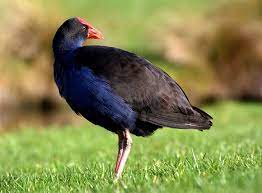
Allen’s Gallinule, sometimes called Allen’s Moorhen, is a species of bird in the rail family. It is found in Mexico, Central and South America, and in the United States, mainly the south-western states.
Allen’s Hummingbird
The Allen’s Hummingbird is a species of hummingbird in the family Trochilidae. It is the only endemic bird of Arizona. The Allen’s Hummingbird is a permanent resident of the Grand Canyon area, and migrates short distances outside the area.
Alpine Munia
The Alpine Munia, Lonchura altaica, is a small passerine bird in the finch family Fringillidae. It is endemic to the alpine tundra of the Himalayas, where it is found in rocky areas. It feeds on seeds, insects, and berries, and builds its nest in a rock crevice. It breeds in the Himalayas, from Pakistan to eastern Nepal, and winters in the Indian subcontinent.
Alpine Pipit
The Alpine Pipit (Anthus castaneus) is a passerine bird in the pipit and wagtail family Motacillidae. It is a small bird which breeds in the Himalayas, from Pakistan to eastern Nepal, and winters in the Indian subcontinent. It is migratory, wintering in southeast Asia.
Alpine Robin
The Alpine Robin, Sicalis alpicola, is a bird in the Australasian robin family Petroicidae. Its natural habitats are temperate forests and temperate shrubland. It is threatened by habitat loss.
Alpine Swift
The Alpine Swift, Apus melba, is a small bird in the swift family Apodidae. It has brown upperparts and a white throat. The wings are blackish-brown with pale fringes. It breeds in the Himalayas, from Pakistan to eastern Nepal, and winters in the Indian subcontinent. It is migratory, wintering in southeast Asia.
Altai Snowcock
The Altai Snowcock, Tetraogallus altaicus, is a species of bird in the pheasant family Phasianidae. It is endemic to Turkey.
Altamira Oriole
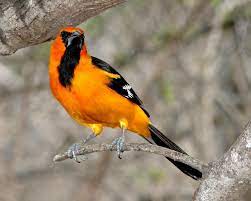
The Altamira Oriole, Oriolus traillii, is a species of bird in the family Oriolidae. It is endemic to Mexico.
Altamira Yellowthroat
The Altamira Yellowthroat, Geothlypis flavicollis, is a species of bird in the family Thraupidae. It is endemic to Mexico. It is threatened by habitat loss.
Amami Thrush
The Amami thrush, Turdus amaurochalinus, is a species of bird in the thrush family. It is found in the Ryukyu Archipelago and Okinawa Islands of Japan, and in the Marianas Islands.
Amami Woodcock
The Amami Woodcock, Scolopax amamiensis, is a large, stocky bird of the woodcock family Scolopacidae. This is a rare and endemic subspecies.
Amani Sunbird
The Amani sunbird, Nectarinia amaniensis, is a large, rufous-capped, long-tailed, brown sunbird, which is found in forests of the Amami Islands near Japan.
Amaui
Amaui, or Amaui, is a genus of lizards in the family Agamidae. The genus contains two species, both endemic to the island of Amaui in French Polynesia. Amauis vidua is small, about 15 cm long, with a large, broad head and a short, thick tail. It is found in open dry scrubland habitats. Amauis spilota is larger, with a maximum of 30 cm, and is found in rainforest.
Amazilia Hummingbird
The Amazilia hummingbird, Amazilia waldeni, has a red throat, a black stripe on its chest and a narrow tail. The male and female are different in appearance. The male is larger than the female and has a black, notched tail. It is found in the Amazilia archipelago in French Polynesia.
Amazon Kingfisher
The Amazon Kingfisher, Todiramphus sanctus, is a medium-sized bird of prey that is endemic to the Amazon Rainforest in South America. It is a member of the family Alcedinidae. As its name implies, this species is closely related to the kingfishers and is the only member of the genus Todiramphus.
Amazonian Antpitta
The Amazonian Antpitta, Grallaria gigantea, is a species of bird in the antbird family, Thamnophilidae. It is a member of the monotypic genus Grallaria. It is found in lowland and montane forests and grassland in the Amazon Basin, and the Guianas.
Amazonian Antshrike
The Amazonian Antshrike, Thamnomanes caesius, is a species of bird in the antbird family, Thamnophilidae. It is a member of the monotypic genus Thamnomanes. It is found in lowland and montane forests and grassland in the Amazon Basin, and the Guianas.
Amazonian Black-Tyrant
The Amazonian Black-Tyrant, Dendrocolaptes platyceros is a large, slender, long-tailed, black bird of the tropics. It is one of the largest birds in the world, and is the largest native bird in South America. The species is found in the lowlands of eastern Brazil and northern Bolivia.
Amazonian Oropendola
The Oropendola is a small parrot, about 12–15 cm long, with a body colour in the male of a warm rusty-orange with a black head and neck, with white underparts; the female is a light greenish-olive with a greenish-yellow head and neck, and yellowish underparts. Its call is a low, mournful, croaking “kook-a-kook-a”.
Amazonian Parrotlet
The Amazonian Parrotlet is a small parrot of the Neotropics. It is a member of the Psittacidae family. Like all parrots, it is omnivorous, feeding on fruit, seeds, insects, nectar, and small vertebrates. It is greenish colored with a black and white pattern on the face, and a black cap and tail.
Amazonian Scrub-Flycatcher
The Amazonian Scrub-Flycatcher, Phaenicophilus sumatranus, is a medium-sized, long-tailed, fairly thick-bodied, dark-bodied flycatcher-like bird of the tropical forests of the western Amazon basin and adjacent Andes.
It is a rather inconspicuous bird of the understory of humid forests. The species is found in lowlands between 0–400 m in the western Amazon, eastern Peru and northwestern Colombia.
Amazonian Umbrellabird
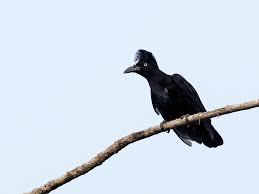
The Amazonian Umbrellabird, Umbrella bird, is a small, greenish-brown bird of the rainforest. It is about 13 to 15 cm long and weighs 14 to 18 grams. It has a broad, dark bill and a very broad rounded wings which are used for gliding.
Ambon Yellow White-eye
The Ambon Yellow White-eye, Zosterops amboinensis, is a small bird of the estuary and mangrove areas of the island of Ambon in Indonesia. It is one of the most abundant cormorants in the world, with a global population estimated at 1.2 – 1.6 million individuals.
Amchitka Cormorant
The Amchitka Cormorant, Phalacrocorax atriceps, is a small to medium-sized cormorant, found in the coastal waters off the Alaska Peninsula and Kodiak Island, Alaska.
American Avocet
The American Avocet, Recurvirostra americana, is a rare shorebird of wetlands, rivers, and lakes. It is a medium-sized, slender-necked, wader.
American Bittern
The American Bittern, Botia meridionalis, is a rare North American bird of freshwater and saltwater wetlands and estuaries. It is a medium-sized, aquatic, short-necked, wader of mature to old-mature deciduous and coniferous forests, including those on floodplains and prairies.
American Black Duck
The American Black Duck, Anas rubripes, is a large duck found in North America south of the Laurentide Ice Sheet. It is the world’s only diving duck.
It is the only duck species that breeds in both the northern and southern hemisphere, although the breeding populations in the northern hemisphere winter in the southern hemisphere. The American Black Duck is one of the most common ducks in the U.S. and Canada.
American Coot
The American Coot, Fulica americana, is a small to medium-sized wading bird of the Americas. It is a member of the family Fulvicidae, the rails. The species is found in the Americas, ranging from Mexico to Argentina.
American Dipper
The American Dipper, Cinclus mexicanus, is a small bird of prey that is found in North America. It is also a member of the order Falconiformes, the falcons. It is a medium-sized bird of prey with long, light, dihedral wings with a pointed tip and a deep notch. Its legs are long and slender, as well as its tail. The American Dipper’s plumage varies from light brown to greyish-brown, sometimes with white feathers on its face. The species is a rare vagrant in Europe.
American Goldfinch
The American Goldfinch, Carduelis tristis, is a small yellow songbird of the Americas. It is a member of the family Fringillidae, the finches. The species is a small passerine bird with a long tail and a conspicuous eye ring. It is found in most of North America.
American Golden-Plover
The American Golden-Plover, Pluvialis dominica, is a small to medium-sized ground-feeding bird of the Americas. It is a member of the family Charadriidae, the waders. It is a migratory wader that winters in the southern hemisphere.
American Harrier
The American Harrier, Hareter melanocephalus, is a medium-sized bird of prey found in the Americas. It is a member of the order Falconiformes, the falcons. The species is a medium-sized bird of prey with long, pointed wings, a deep notch at the base of each wing, and a long pointed tail. It is found in the Americas, from the Andes to Tierra del Fuego.
American Kestrel
The American Kestrel, Falco sparverius, is a small to medium-sized bird of prey that is found in the Americas. It is a member of the family Falconidae, the falcons. The species is a medium-sized bird of prey with very long, broad wings, a deep notch at the base of each wing, and a long pointed tail. It is found in the Americas, from the Andes to Tierra del Fuego.
American Mountain Thrush
The American Mountain Thrush, Turdus montanus, is a medium-sized thrush found in the mountains of North America.
It is mostly seen in the western parts of the continent. It is a vocal bird, and its song is a loud and melodious whistle that can be heard for a long distance. It is commonly seen in the spring and summer.
It is a very social species, and is associated with other thrushes, woodpeckers and other birds. It builds a nest near water, and the clutch is usually four eggs.
American Oystercatcher
The American Oystercatcher, Haematopus palliatus, is a medium-sized shorebird with a long black bill. It is a saltwater bird, and feeds on crustaceans and molluscs.
It breeds in the United States, Canada and Alaska, and winters in the southern United States. It is a migratory bird, and the species has been introduced to many parts of the world.
American Pipit or Buff-bellied Pipit
The Pipit is a small passerine bird belonging to the bunting family. It is a bird of the open country, and is usually seen in small flocks.
It is a rather shy and retiring bird, but does not hesitate to defend itself. It is about 18 centimeters long. The sexes are similar, but young birds are a greyish colour. It is a widespread, common and familiar bird.
American Redstart
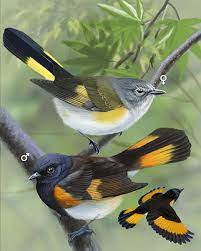
The American Redstart, Setophaga ruticilla, is a small, insectivorous finch found in the Americas. It is mostly a resident species, but migrates at times. It is mainly a bird of forest edges, and the males and females are alike. The eggs are white with brown spots.
American Robin
The Robin is a medium-sized bird of the family Passeridae. It is a common and familiar bird in parks and gardens and in towns and villages, where it is usually seen in small flocks. It is mostly seen in the northern parts of the United States, but it is also found in Canada, and is a regular visitor to Europe. It is a vocal bird, and its song is a series of whistled notes similar to those of the Nightingale.
American Three-toed Woodpecker
The American Three-toed Woodpecker, Picoides dorsalis, is a small, stocky bird of the woodpecker family (family Picidae), which is native to North America. It is one of the smallest woodpeckers, reaching a length of about 10 centimeters.
The male has a bright red crown and nape, and the female’s head is black. The body is a uniform greyish-blue, with a black stripe above.
American White Pelican
The American White Pelican, Pelecanus erythrorhynchos, is an extremely rare bird which is found in the northernmost parts of North America. It is migratory, wintering from the arctic regions of Canada and Greenland to the north-east coast of the USA. It is found in the north-eastern parts of the USA, mainly in the state of New York.
It is a large bird, with a wingspan of up to 1.5 m. Their white plumage is a result of molt and not breeding. They are usually found in large flocks. Its diet consists mainly of fish.
American Tree Sparrow
The American Tree Sparrow, Passerculus sandwichensis, is a small bird found in the forests of the eastern North America. It is migratory and winters in southern Africa. It is generally brown or greyish-brown in colour with white on the belly and a blackish tail. It has a distinctive song. It is found in the boreal forests of north-eastern Canada, along the Atlantic Coast of the USA and in the north-eastern parts of the USA.
American Wigeon
The American Wigeon, Mareca penelope, is a medium-sized bird of prey. Adults are dark brown with a white stripe down the wing, a white patch on the breast and a dark band on the tail. They are found in marshes and wetland areas in the northern regions of North America. They are migratory, wintering to south-eastern USA and Central America, and some of them are found as far south as Brazil.
American Painted-snipe
The American Painted-snipe, Scolopax minor, is a medium-sized bird of prey found in the northern parts of North America. They are migratory and winters in south-eastern USA and Central America, and some of them are found as far south as Brazil.
Amsterdam Island Albatross
The Amsterdam Island Albatross breeds in the south Pacific ocean between Hawaii and Australia. It is one of the smallest albatrosses at around 32 cm long. It is migratory, wintering on the coasts of South Africa and western South America.
Amethyst Woodstar
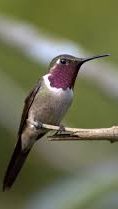
The Amethyst Woodstar is a small bird of tropical America. It is found in South America and Central America. It is migratory, moving from the north to the south. Its call is a high-pitched, descending whistle.
American Woodcock
The American Woodcock, Lagopus muta, is a bird that breeds in the boreal forest of eastern North America. Its breeding habitat is bogs, fens, and marshes, and it is a permanent resident in some parts of the boreal forest, while in other places, such as the prairies, it is a summer visitor which will move south for the winter.
Amethyst Brown-Dove
The Amethyst Brown-Dove, Oena capensis, is a medium-sized brown dove. It is found in the humid montane forests and bamboo thickets of the central and east African tropical forests. It feeds on fruit and nectar, and is a mobile forager.
Amethyst Sunbird
The Amethyst Sunbird, Cinnyris amethystus, is a small bird found in Southeast Asia. It is found in open, dry forests, savannah, and other dry habitats. It feeds on nectar, and migrates south for the winter.
Amethyst-throated Hummingbird
The Amethyst-throated Hummingbird is a small hummingbird of the genus Pitho. It is found in the Andes of Colombia and Ecuador. It is migratory, wintering in the southern Andes highlands of Colombia and Ecuador.
Amethyst-throated Sunangel
The Amethyst-throated Sunangel is a medium-sized bird of tropical America. It is found in South America and Central America. It is migratory, moving from the north to the south. Its call is a high-pitched, descending whistle.
Amethyst-throated Sunbird
The Amethyst-throated Sunbird is a small bird of tropical America. It is found in South America and Central America. It is migratory, moving from the north to the south. Its call is a high-pitched, descending whistle.
Amur Falcon
The Amur Falcon, Falco amurensis, is an Old World falcon. It is the most widespread of the falcon species, found throughout most of Eurasia, from The Arctic circle to Turkey and China, and from North Africa to the Himalayas. During winter it migrates to sub-Saharan Africa and Southeast Asia.
Anambra Waxbill
The Anambra Waxbill, Estrilda paludicola, is a species of bird in the family Estrildidae. It is found in Angola, Benin, Cameroon, the Republic of the Congo, the Central African Republic, the Democratic Republic of the Congo, Ivory Coast, Equatorial Guinea, Gabon, Ghana, Guinea, Liberia, Nigeria, Sierra Leone, Togo, and Uganda. Its natural habitat is subtropical or tropical moist lowland forests.
Ancash Tapaculo
The Ancash Tapaculo, Tapaculo ancashensis, is a species of bird in the family Tupaiidae. It is found in the Andes Mountains of Peru and Ecuador.
Anchieta’s Barbet
The Anchieta’s Barbet, Notopholiton anchietae, is a bird in the Megalaimidae family. It is found in Bolivia and Peru. Its natural habitat is subtropical or tropical moist montane forests.
Anchieta’s Sunbird
The Anchieta’s Sunbird, Cyanomitra anchietae, is a bird in the Nectariniidae family. It is found in Bolivia, Colombia, Ecuador, Peru, and Venezuela. Its natural habitats are subtropical or tropical moist montane forests and subtropical or tropical high-altitude shrubland.
Ancient Murrelet
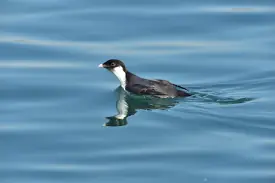
The Ancient Murrelet, Uria aalge, is a seabird in the auk family. It is a small, dark seabird of the Bering Sea, Aleutian Islands, and southern Alaska. It is dark brown above with a paler underside. The bird nests in cliffs and rocky areas, laying one or two eggs.
Andaman Boobook or Andaman Hawk Owl
The Andaman Boobook or Andaman Hawk Owl, Ninox sclateri, is a species of owl in the family Strigidae. It is found in India, Burma, and Thailand. Its natural habitat is subtropical or tropical moist lowland forests. It is threatened by habitat loss.
Andaman Crake
The Andaman Crake, Amaurornis andamanensis, is a species of bird in the family Rallidae. It is found in Myanmar and Thailand. Its natural habitat is subtropical or tropical moist montane forests.
Andaman Cuckoo-Dove
This species is found throughout the Andaman Islands and also in northern Andaman.
It is a small, long-tailed dove, resembling the Oriental cuckoo dove. It has a striking white crown and white rump. It has a loud cuckoo-like call, and it feeds on seeds and insects. It builds a stick nest in a tree. The female incubates the two eggs for 22 or 23 days. The male and female are always together, and the male helps with the incubation and feeding.
Andaman Drongo
This large species is found in Andaman and Nicobar islands. It is common on the Nicobar Islands, especially in the southern areas. It has a short tail, long neck and legs, and a short bill.
It has a loud croaking call, and it feeds on fruits and berries.
It builds a nest of sticks, and the female incubates the two eggs for 22 or 23 days. The male feeds the young.
Andaman Scops-Owl
This species is found in the Andaman Islands and on the Nicobar Islands.
It has a short tail, long legs and a short bill. It has a loud call, and feeds on fruits, berries, and small animals.
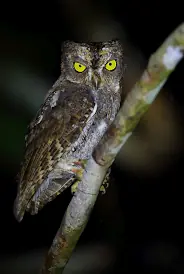
It builds a stick nest, and the female incubates the two eggs for 22 or 23 days. The male feeds the young.
Andaman Treepie
This small, terrestrial bird is found throughout the Andaman Islands and on the Nicobar Islands. It is a shy, nocturnal bird, and lives in the forest undergrowth. It has a distinct head pattern, black above, white below, a grey bill, and a grey tail.
Andaman Wood-Pigeon
This is a small, medium-sized, pigeon, which is a member of the family Columbidae. It is found throughout the Andaman Islands. It is a shy, nocturnal bird, and lives in the forest undergrowth. It has a distinct head pattern, black above, white below, a grey bill and a grey tail.
Andean Avocet
The Andean Avocet, Recurvirostra andina, is a wader in the avocet and stilt family, Recurvirostridae. It breeds in Argentina, Bolivia, Chile, Colombia, Ecuador, and Peru. The Andean Avocet is a bird of inland wetlands. It lays two eggs on a floating nest. This bird is endangered due to habitat loss.
Andean Cock-of-the-rock
The Andean Cock-of-the-rock is a species of bird in the Ptilonorhynchidae family. It is found in Argentina, Bolivia, Chile, and Peru. Its natural habitat is subtropical or tropical high-altitude grassland. It is threatened by habitat loss.
Andean Condor
The Andean Condor is a species of South American bird in the New World vulture family Cathartidae and is the only member of the genus Vultur. It is the largest flying land bird in the Western Hemisphere and has the largest wingspan of any land bird in the world.
Andean Duck
The Andean Duck is a species of duck that breeds in Argentina, Bolivia, Chile, and Peru, and migrates northward as far as the United States. It spends its winters in southern South America.
Andean Emerald
The Andean Emerald, is a species of hummingbird in the Trochilidae family.
Andean Flamingo
The Andean flamingo is a flamingo in the genus Phoenicopterus. It is a distinctive species with dark-pink plumage and red or orange bills with a knobbed tip. It breeds on high-altitude Andean plateaus (3,000–4,500m) from Colombia to northern Chile and Argentina, and also in the Falkland Islands. It is the national bird of Bolivia, Chile, Colombia, Ecuador and Peru.
Andean Flicker
The Andean Flicker is a woodpecker in the genus Colaptes. It is found in humid forest, woodland, plantations, parks and gardens in the Andean piedmont and highlands from southern Colombia, northern Ecuador and Peru south to northern Argentina and Chile, and on Trinidad.
Andean Goose
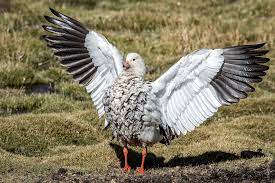
The Andean Goose is a South American species of goose. It has white feathers with black wing tips.
Andean Guan
The Andean Guan is a species of chachalaca, a group of near passerine birds from tropical Central and South America.
Andean Gull
The Andean Gull, Larus serranus, is a large gull which breeds in inland parts of western South America. It is migratory, wintering in the lower altitudes of the northern half of South America.
Andean Hillstar
The Andean hillstar, Oreotrochilus estella, is a hummingbird found from southwestern Colombia to northwestern Argentina.
Andean Ibis
The Andean ibis, Plegadis falcinellus, is a wading bird in the ibis and spoonbill family, Threskiornithidae.
Andean Lapwing
The Andean Lapwing is a medium-sized, round-winged, short-tailed, rufous and white bird of the southern Andes. It is a small, stocky, short-legged bird with short wings. The males of this species are larger than the females
Andean Negrito
The Andean Negrito, also known as the Andean Potoo or Andean Pygmy Owl, is a small, stocky, short-legged New World bird. It is a brownish-grey bird with a short tail and a large black and white moustache, and has a rufous chin. Its long, straight, down-curved bill is black, but the rest of its facial skin is white.
The plumage of the Andean Pygmy Owl, as it is called in Venezuela and Colombia, resembles that of the Andean Lapwing, but the Andean Pygmy Owl is smaller, stockier and has a longer tail.
Andean Parakeet
The Andean Parakeet is a small, short-tailed, rufous coloured parakeet from southern Chile to southern Argentina, similar to the Andean Parakeet, but with a paler head and a longer tail. It is a non-migratory, non-colonial bird and often occupies the same habitat as the Andean Parakeet.
Andean Siskin
The Andean Siskin is a small, long-tailed, rufous coloured siskin from the southern Andes mountains of Bolivia, Peru and Chile, similar to the Andean Snipe, but with a less rufous breast. It is a non-migratory, non-colonial bird found mainly in the open, grassy areas of the Andean foothills.
Andean Slaty-Thrush
The Andean Slaty-Thrush is a small, short-tailed, rufous coloured bird of the southern Andes mountains of Bolivia, Peru and Chile, similar to the Andean Siskin and the Andean Thrush, but with a finer, dainty appearance. It is a non-migratory bird found mainly in the open, grassy areas of the Andean foothills.
Andean Solitaire
The Andean Solitaire (Myadestes elizabethae) is a passerine bird in the tyrant flycatcher family. It is found in the Andean foothills of Colombia, Ecuador, and Venezuela. It is small (13 cm long), dark grey above, and white below with a brown cap and a distinctive white throat patch. It is active primarily at dawn and dusk, and flies rapidly in search of insects.
Andean Swallow
The Andean Swallow (Tachycineta albiventer) is a species of bird in the family Hirundinidae. It is endemic to the Andes of Colombia and Ecuador. Its natural habitat is subtropical or tropical moist montane forests. It is threatened by habitat loss.
Andean Swift
The Andean Swift (Cypseloides squamiger) is a small bird in the swift family Apodidae. It is found in Colombia and Ecuador.
Andean Tapaculo
The Andean Tapaculo (Scytalopus aequatorialis) is a species of bird in the Cracticidae family. It is found in Colombia and Ecuador. Its natural habitat is subtropical or tropical moist montane forests.
Andean Tinamou

The Andean Tinamou (Ortalis hospes) is a species of bird in the Tinamidae family. It is found in Bolivia, Colombia, Ecuador, and Peru. Its natural habitat is subtropical or tropical high-altitude shrubland. It is threatened by habitat loss.
Andean Tit-Spinetail
The Andean Tit-Spindletail (Leptasthenura andicola) is a species of bird in the Furnariidae family. It is found in Colombia and Ecuador.
Andean Tyrant
The Andean Tyrant (Neopelma chrysoconus) is a species of bird in the tyrant flycatcher family. It is found in the Andes of southern Colombia, Ecuador, and Venezuela. Its natural habitat is subtropical or tropical moist montane forest.
Angola Babbler
The Angola Babbler (Neococincla angolensis) is a species of bird in the Cotingidae family. It is found in Angola and Democratic Republic of the Congo. Its natural habitat is subtropical or tropical moist montane forests.
Angola Batis
This bird is found in Angola, Namibia, Botswana, Zambia, and Zimbabwe. The male is unmistakable with its bright red bill and black eye stripe. The female is duller and browner, and the juveniles lack the red bill. It is mostly found in arid areas.
Angola Cave-Chat
The cave-chat is a species of bird in the Leiothrichidae family. The species is endemic to Angola and reaches a length of about . It is found from sea level to about .
Angola Cisticola
The Angola Cisticola is a species of bird in the Cisticolidae family. It is found in Angola, Botswana, Malawi, Mozambique, Namibia, South Africa, Tanzania, Zambia, and Zimbabwe. Its natural habitat is dry savanna.
Angola Lark
The Angola Lark is a species of bird in the Alaudidae family. It is found in Angola, Botswana, Namibia, South Africa, Swaziland, Zambia, and Zimbabwe. Its natural habitats are dry savanna and subtropical or tropical dry shrubland.
Angola Slaty-Flycatcher
The Angola Slaty-Flycatcher is a species of bird in the Muscicapidae family. It is found in Angola, Botswana, Namibia, South Africa, Swaziland, Zambia, and Zimbabwe. Its natural habitats are dry savanna and subtropical or tropical dry shrubland.
Angola Swallow
The Angola Swallow is a species of bird in the Hirundinidae family. It is found in Angola, Botswana, Namibia, South Africa, Swaziland, Zambia, and Zimbabwe. Its natural habitat is dry savanna.
Anhinga
This bird is a fish-eating bird with a distinctive long neck, long, pointed wings, and a flattened body. They are found near lakes and rivers in Central and South America, including Mexico, Central America, and the Caribbean.
Anianiau
This bird can be found in tropical and subtropical forest, and also in rainforests. It eats mainly insects but also eats fruit. The Anianiau is an endangered species, as it is hunted for the pet trade.
Anjouan Brush-Warbler
The Anjouan Brush-Warbler is a species of bird in the family Sylviidae. It is endemic to Anjouan, and is listed as critically endangered by the IUCN.
Anjouan Scops-Owl
It is a species of bird in the family Scopidae. It is endemic to Anjouan, and is listed as endangered by the IUCN.
Anjouan Sunbird
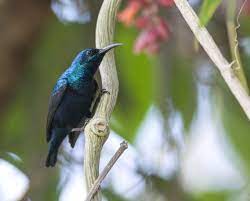
The Anjouan Sunbird (Cinnyris rupestris) is a species of sunbird in the family Nectariniidae. It is found in Comoros, Mayotte and Madagascar. Its natural habitats are subtropical or tropical dry forests and subtropical or tropical moist lowland forests. It is threatened by habitat loss.
Ankober Serin
The Ankober Serin (Serinus ankoberensis) is a species of serin native to Africa.
Anna’s Hummingbird
The Anna’s Hummingbird (Calypte anna) is a small hummingbird that breeds in southern Canada, the eastern and south-central United States, and the extreme southwestern corner of Alaska. Its range extends through the Rocky Mountains south to California and the western Great Plains, and east through the eastern United States to the Atlantic Ocean.
Annam Partridge
The Annam Partridge (Alectoris annae) is a species of bird in the family Phasianidae. It is found in Angola, Benin, Burkina Faso, Burundi, Cameroon, Central African Republic, Chad, Republic of the Congo, Democratic Republic of the Congo, Equatorial Guinea, Ethiopia, Gabon, Gambia, Ghana, Guinea, Guinea-Bissau, Kenya, Liberia, Malawi, Mali, Mauritania, Niger, Nigeria, Rwanda, Senegal, Sierra Leone, Somalia, South Sudan, Sudan, Tanzania, Togo, Uganda, and Zambia.
Annobon Paradise-Flycatcher
The Annobon Paradise-Flycatcher (Terpsiphone annobona) is a species of bird in the family Tityridae. It is found in Angola, Cameroon, Central African Republic, Republic of the Congo, Democratic Republic of the Congo, Equatorial Guinea, Gabon, Gambia, Ghana, Guinea, Guinea-Bissau, Kenya, Liberia, Nigeria, Rwanda, Sierra Leone, South Sudan, and Uganda.
Annobon White-eye
The Annobon White-eye (Zosterops ansorgei) is a species of bird in the family Zosteropidae. It is found in Angola, Cameroon, Central African Republic, Republic of the Congo, Democratic Republic of the Congo, Equatorial Guinea, Gabon, Gambia, Ghana, Guinea, Guinea-Bissau, Kenya, Liberia, Nigeria, Rwanda, Sierra Leone, South Sudan, and Uganda.
Ansorge’s Greenbul
The Ansorge’s Greenbul (Phyllastrephus ansorgei) is a species of bird in the family Sylviidae. It is found in Burundi, Democratic Republic of the Congo, Rwanda, and Uganda.
Antarctic Petrel
The Antarctic Petrel (Pelecanoides antarcticus), also known as the Antarctic Fulmar, is a small seabird which breeds on sub-Antarctic islands, primarily South Georgia and South Sandwich Islands. It is the most southerly bird in the world.
Antarctic Prion
The Antarctic Prion (Pachyptila desolata) is a bird belonging to the prion genus of the auk family. They breed on islands in the South Atlantic Ocean, mainly South Georgia and South Sandwich Islands.
Antarctic Shag
The species breeds on the Antarctic continent, mainly on Macquarie Island. One of the smallest of the cormorants, it nests in colonies on rocky islands or on stacks or ledges of cliffs. It feeds on fish, and is largely nocturnal.
The Antarctic Shag is a much sought-after game bird, and is shot for meat. The flesh is marketed under several names, including “blue shag”, “blue cormorant”, “blue shaglet” and “blue shaglet”.
Antarctic Tern
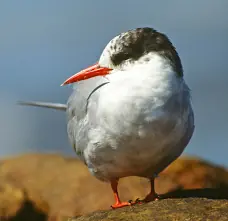
The species breeds on Antarctic islands north of the Antarctic Circle, including South Georgia, the South Orkneys, the South Shetlands, the South Sandwich Islands, Kerguelen and Heard islands.
Antarctic or Southern Giant-Petrel
This remarkably confiding seabird, with its bright white throat, is amongst the rarest and most threatened of all seabirds. The species breeds on South Georgia, the South Orkneys, the South Shetlands, the South Sandwich Islands, Kerguelen, Heard and Macquarie islands. The population on South Georgia is estimated at only 250 pairs.
Antillean Crested Hummingbird
The species occurs in upland forest, particularly on Antillean islands, and in lowland forest. Nesting takes place in tree cavities or deserted woodpecker holes. It feeds on nectar from flowers, fruit and insects.
Antillean Euphonia
The Antillean Euphonia is a small passerine bird. Its plumage is black, with white barring across the wings and tail. The sexes are similar in appearance. It inhabits forest, woodland, and scrubland, sometimes including coconut palms. The Antillean Euphonia feeds on insects and berries. It builds an open cup nest which it shares with up to three other individuals.
Antillean Mango
The Antillean Mango is a small passerine bird. Its plumage is black, with white barring across the wings and tail. The sexes are similar in appearance.
It is found in the Greater Antilles. It inhabits forest, woodland, and scrubland, often including coconut palms. It mainly feeds on insects and berries. It builds an open cup nest which it shares with up to three other individuals.
Antillean Nighthawk
The Antillean Nighthawk is a small nocturnal passerine bird. Its plumage is brown above and white below, with fine dark streaking on the head. There is a white eye ring. The sexes are similar in appearance. It inhabits forest, woodland, and scrubland, often including coconut palms.The Antillean Nighthawk feeds on insects and berries. It builds an open cup nest which it shares with up to three other individuals.
Antillean Palm-Swift
The Antillean Palm-Swift is a small passerine bird. Its plumage is black above and below. The sexes are similar in appearance. The Antillean Palm-Swift is common in the Greater Antilles, but it’s current habitat is much larger. It inhabits forest, woodland, and scrubland, often including coconut palms.
The Antillean Palm-Swift feeds on insects and berries. It builds an open cup nest which it shares with up to three other individuals.
Antillean Piculet
The Antillean Piculet is a small passerine bird. Its plumage is black above, white below and on the wings. The sexes are similar in appearance.
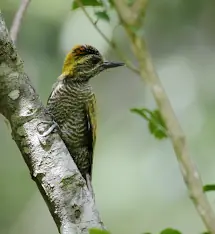
The Antillean Piculet is restricted to the Greater Antilles. It inhabits forest, woodland, and scrubland, often including coconut palms.
The Antillean Piculet feeds on insects and berries. It builds an open cup nest which it shares with up to three other individuals.
Antillean Siskin
The Antillean Siskin is a small bird of the wren family. It is a resident breeder in the Lesser Antilles. It is a ground-dwelling and insectivorous bird. The nest is a cup of grasses lined with fine grass and plant down, placed in a shrub or tree. It is built and incubated by the female. There are usually two eggs in the nest. The male’s song is a sharp, whistling che-che-che-che.
Antillean Wren
The Antillean Wren is an endemic species of Antillean islands. It is a small bird of passerine birds that builds a cup nest low in a shrub. The nest is made of grasses and plant down. The male sings a whistled song. The female incubates the eggs and feeds the nestlings.
Antioquia Bristle-Tyrant
The Antioquia Bristle-Tyrant is a large bird of the northern Amazon Basin. It has a yellow-green body and a black head, with a red throat and breast. It lives in the canopy of the tropical rainforest, feeding on insects. It has a loud song in the mornings.
Antipodes Parakeet
The Antipodes Parakeet is a parrot from the subfamily Platysteirinae. It is also known as the Antipodes Parakeet or the Antipodes Parakeet-Parakeet or Antipodes Parakeet-Parakeet. It is closely related to the other Antipodes parakeet, the Chatham Island Parakeet. It is endemic to the Antipodes Islands in the south Pacific Ocean. It is a ground-dwelling, omnivorous parrot. It forages for food on the ground. It is known to nest in the crowns of tall trees. The nest is a large platform of sticks lined with grasses and plant down. The female incubates the eggs and feeds the nestlings.
Aplomado Falcon
The Aplomado Falcon is a large bird of prey in the family Falconidae. It is endemic to the Atlantic coastal lowlands of the Brazilian coast. It is sometimes known as the black falcon or black-shouldered falcon. It is the largest falcon of the Americas, and is one of the fastest birds. It is a very large bird of prey with a black head and tail. It has a white throat, a black body with a white underwing and white outer tail feathers. The wing tips are also black. It hunts mammals, mainly paca, opossums and rodents.
Apo Myna
The Apo myna is a small and colourful oriental bird of the family Mimidae. It is of the order Passeriformes. It is a passerine bird with a long tail and short legs. It is a resident in the tropical rainforests of the Indian subcontinent and the Indo-Malay archipelago. It is a short-tailed, short-winged bird. It has a characteristic loud and resonant call.
Apo Sunbird
The Apo sunbird is a small passerine bird of the sunbird family. It is a resident in forests of the north-east of India, Myanmar, Thailand, Cambodia and Laos. It is a short-tailed, short-winged bird. It has a characteristic loud and resonant call. It feeds on insects, nectar and fruit.
Apolinar’s Wren
This bird has a brownish-crimson back, white belly, and bright yellow thighs and undertail coverts. Its bill and legs are black and it has a grey head. The species is found in open woodland, savanna, and scrub. The species is monogamous and the male finds a nest site, incubates the eggs and cares for the young.
Apostlebird
The Apostlebird is found in tropical woodlands and scrub, preferring the drier regions. They feed mainly on insects, and hunt by hopping from branch to branch. Breeding occurs in the rainy season, and the male builds a nest in a tree, and the female lays 2-3 white eggs which are incubated for 14-16 days.
Appert’s Greenbul
The species is found in Africa from Senegal to Ethiopia, and in parts of the Middle East. Appert’s Greenbuls feed in dense vegetation or low shrubbery. They live in small family groups with a mated pair of adults, their chicks, and juveniles. The species is monogamous, and the two adults stay together year round, with breeding seasons in winter and spring. The species builds its nest in a shrub or on the ground.
Apricot-breasted Sunbird
The species is found in tropical and subtropical Africa, from the Sahel to Ethiopia, and in Arabia, Yemen, and Somalia. The species feeds on nectar, insects, and fruit, and nests in trees or bushes.
Apurimac Spinetail
This bird is found only in Ecuador. It is found mostly in lowland areas, and prefers areas with dense vegetation. The species is found in hilly areas, and builds a nest in a tree. It feeds mostly on nectar and insects, and is monogamous.
Aquatic Warbler
The species is found in tropical South America, and nests in dense vegetation, usually near water. It mainly feeds on insects, berries, and nectar.
Arabian Babbler
The species is found in tropical Asia, Africa, Australia, and New Guinea. The species breeds in the monsoon season. The male builds the nest and the female lays 3-4 eggs, which are incubated for 15-17 days. The species feeds on insects, especially bees.
Arabian Bustard
The species is found in tropical Asia, Africa, Arabia and Indonesia. This species is endemic to the Arabian peninsula and breeds in grasslands. The male builds a nest on the ground. The species feeds on insects, especially bees.
Arabian Golden-Sparrow
The species is found in Africa, and breeds in grassy areas. The male builds the nest on the ground. It feeds on seeds, grains and insects.
Arabian Partridge
The species is found in Asia, Africa, Arabia, and Indonesia. The species breeds in open areas, and feeds on seeds, grains, and insects.
Arabian Waxbill
Arabian Waxbills are medium sized, glossy, black birds with a long tail. The males are more heavily built than females. They are black and white, with a red bill and feet. The female Waxbill has a black head, neck and upper breast, white belly and flanks, and dark brown undertail coverts. The males have a pale grey eye ring. The Arabian Waxbill is a fairly common visitor to gardens, parks and open country. It feeds primarily on seeds and berries, but will also take buds, buds, nectar, and insects.
Arabian Wheatear
The Arabian Wheatear, like all wheatears, has a large head, long slender beak and fairly long legs. The head is pale grey and the back and wings are grey-brown with a dark rump. The tail is black. A male has a black cap, black wings, a grey back and a grey bill.
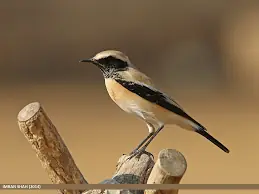
The female is brown above and white below. The Arabian Wheatear is monogamous with a nest built on the ground or low in a bush. It lays 3 white eggs. The chicks are covered in white down and are fed by both parents.
Arabian Woodpecker
Arabian Woodpeckers are ground dwelling birds that feed mainly on ants. They are similar in appearance to the Indian Woodpecker. The Arabian Woodpecker is dark grey-brown above, with a narrow white line on the face. The underside is white. The forehead and crown are black. The male has a blue-grey throat, and the female has a deep brown throat. The toes and bill are blue-grey. The males have blue irises.
Araucaria Tit-Spinetail
The Araucaria Tit-Spinetail is a small passerine bird with a distinctive grey body, black-grey wings and a black tail. It is endemic to Australia. The species is sexually dimorphic. The male has a black head and throat, a grey-brown back, and a gray-brown breast and belly. The females have black wings and a black tail. The species is monogamous and nests in tree cavities. The nest is a deep cup made of dried grass and lined with plant down. The species feeds on insects, spiders, snails, small birds, and nectar.
Archbold’s Bowerbird
This Bowerbird is found in New Guinea. The species is sexually dimorphic. The male has a black head, similarly colored body, and a black tail. The female is paler, has paler eye ring, and is duller than the male. The species is monogamous. The species builds a nest in a tree and incubates the eggs alone. The species feeds on insects, spiders, and nectar.
Archbold’s Newtonia
Archbold’s Newtonia is the sole species in the genus. It is endemic to Australia and it inhabits rainforest. The species is monogamous and builds a nest in a tree. The species feeds on ants, beetles, caterpillars, and nectar.
Archbold’s Owlet-Nightjar
Archbold’s Owlet-Nightjar is very secretive and difficult to see. It is nocturnal and builds a nest on the ground. It feeds on insects, spiders, and nectar.
Archer’s Buzzard
Archer’s Buzzards are medium-sized raptors. The species is sexually dimorphic. The male has a blackish crown, a blackish wing tip, and a blackish rump. The female is paler, has paler eye ring, and is duller than the male. The species is monogamous. Archer’s Buzzards feed primarily on small mammals, insects, reptiles, and birds.
Archer’s Lark
Archer is named after him. Archer’s Lark is found in open grasslands and semi-desert regions of southern Africa. The male is unmistakable with its long black bill and rufous breast.
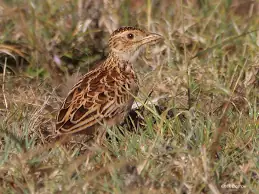
The female is duller with a pale forehead and rufous breast. Archer’s Lark is found in a variety of habitats from dry savannah to riverine thickets. It feeds on the ground or on bushes.
Archer’s Robin-Chat
Archer’s Robin-Chats are commonly found in open grassland, savanna, and semi-desert areas of western Africa. They breed in open woodland, and can be found near water.
This bird is 11 to 14 inches in length, with a grey body and black flight feathers. The tail is black above, white below, and the tail feathers have white tips. The forehead and eyes are white and the breast is rufous. The head is black and the legs are also black.
Arctic Loon
The Arctic Loon’s breeding habitat is Arctic tundra. It migrates to winter in coastal areas, including Massachusetts. The Arctic Loon eats mainly small schooling fish or insects, but it also feeds on marine mammals.
Arctic Tern
Arctic Terns are large, white seabirds. They nest in colonies in Arctic tundra. Arctic Terns fly on open water or in shallow waters.
Arctic Warbler
Arctic Warblers are mid-sized warblers, with olive-green upperparts and pinkish underparts. They breed in Arctic tundra and migrate to northern North America. Arctic Warblers have a very distinct song.
Arfak Astrapia
The Arfak Astrapia is a passerine bird, also known as Arfak Honeyeater and Adjutant Honeyeater to distinguish it from other honeyeaters. It breeds in arid, open woodlands, savannas, and grasslands in northern Australia and New Guinea.
Arfak Honeyeater
Arfak Honeyeaters are medium-sized honeyeaters, with olive-green upperparts and pinkish underparts. The males have a black crown, black back, black and white wing bars, and a black eye stripe. They breed in arid woodlands in northern Australia and New Guinea.
Armenian Gull
The Armenian Gull is a large gull, with mottled brown upperparts and a white lower belly. It breeds in streams and lakes of central Asia.
Arrow-marked Babbler
Arrow-marked Babblers are found in woodlands and forests of southeastern Asia. They have a soft, sweet, whistled song.
Arrowhead Warbler
Arrowhead Warblers are grey-brown birds with brown wings and black underparts. They breed in grasslands and shrublands in east Asia.
Ascension Frigatebird
This large seabird, which breeds in tropical and subtropical South America, is a pelagic species, spending much of the year at sea. It eats mainly fish, but also small crustaceans, squid and octopus. It builds a bulky stick nest which is placed in the fork of a tree, or on a palm or rock. The clutch consists of 1-3 eggs.
Ash’s Lark
The Ash’s Lark is a medium-sized dusky-brown bird. The male has a grey head and backs, chestnut wings, black tail and underparts and a white supercilium. The female is paler below, and without chestnut markings. The species is resident in most of its range, but migrates from the far north.
Ash-breasted Antbird
This inconspicuous antbird is brown above with pale whitish underparts. The sexes are similar, but the female is paler below and the juvenile is duller and buffier below. It is resident in the Amazon basin and much of eastern Brazil.
Ash-breasted Tit-Tyrant
The Ash-breasted Tit-Tyrant is a medium-sized antbird. The male has a grey back, sides, head, and nape, and a black vent. The breast and upperparts are white, and there is a blackish crown and the blackish supercilium. The female is paler below, and has grey underparts. The species is resident in much of its range, but migrates from the far north.
Ash-browed Spinetail
This small passerine bird is brown above, paler below, and has a pale supercilium. The sexes are similar. It breeds in much of Central America, and is territorial, defending its nesting territory from intruders. The nest is on the ground or in a tree. The clutch is 2-4 eggs.
Ash-colored Cuckoo
The Ash-colored Cuckoo is a passerine bird. The adult is dull, olive-brown above, with pale buff underparts, and a white supercilium. It has a blackish crown and a blackish supercilium. The species is resident in much of Central America.
Ash-colored Tapaculo
The Ash-colored Tapaculo is a medium-sized bird. It is brownish above, paler below, and has a white supercilium. The sexes are similar. It breeds in much of Central America, and is territorial, defending its nesting territory from intruders. Its nest is on the ground or in a tree. The clutch is 2-4 eggs.
Ash-throated Antwren
This bird is found in semiarid scrub and grassland, usually near water, and is most common along rivers. It is a small bird with brown upperparts, a grey breast, a grey head, and whitish underparts. The male has a black throat edged with whitish and a black eye stripe. The female has a grey throat and breast, and a brighter eye.
Ash-throated Casiornis
This bird is found in flocks, often near water. It is a small bird with brown upperparts, a grey breast, a grey head, and whitish underparts. The male has a black throat edged with whitish and a black eye stripe. The female has a grey throat and breast, and a brighter eye.
Ash-throated Crake
It breeds from southern Mexico to Bolivia, and east of the Andes to Peru. It is widespread in grassland and marshes, also in agricultural areas, and on wooded hillsides. It nests on the ground, laying two or three brown eggs. It feeds on insects, seeds, and spiders, and is also a garden pest.
Ash-throated Flycatcher
This species is widespread from southern Mexico through Central America and the West Indies to northern South America. It is found in moist habitats from sea level to 1500 m (5000 ft). It breeds in open country, often near water, and is often found in woodland. It nests on the ground, laying two or three brown eggs. It feeds on insects, seeds, and spiders, and is also a garden pest.
Ash-throated Gnateater
This bird is found in forest edges, woodland, and cultivated areas. It breeds from southern Mexico to Bolivia, and east of the Andes to Peru. It is widespread in grassland and marshes, also in agricultural areas, and on wooded hillsides. It nests on the ground, laying two or three brown eggs. It feeds on insects, seeds, and spiders, and is also a garden pest.
Ash-throated Warbler
This species is found in open country from southern Mexico to Bolivia, and east of the Andes to Peru. It is widespread in grassland and marshes, also in agricultural areas, and on wooded hillsides. It nests on the ground, laying two or three brown eggs. It feeds on insects, seeds, and spiders, and is also a garden pest.
Ash-winged Antwren
This bird is found in scrub and grassland from southern Mexico through Central America and the West Indies to northern South America. It is found in moist habitats from sea level to 1500 m (5000 ft). It breeds in open country, often near water, and is often found in woodland. It nests on the ground, laying two or three brown eggs. It feeds on insects, seeds, and spiders, and is also a garden pest.
Ashy Antwren or Yungas Antwren
The Ashy Antwrens, also known as Yungas Antwrens, are small, stocky birds. The species is widespread from southern Mexico through Central America and the West Indies to northern South America. It is found in moist habitats from sea level to 1500 m (5000 ft). It breeds in open country, often near water, and is often found in woodland. It nests on the ground, laying two or three brown eggs. It feeds on insects, seeds, and spiders, and is also a garden pest.
Ashy Bulbul
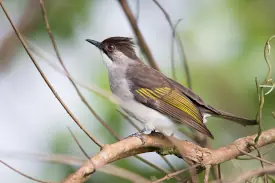
This bird is found in open country from southern Mexico to Bolivia, and east of the Andes to Peru. It is widespread in grassland and marshes, also in agricultural areas, and on wooded hillsides. It nests on the ground, laying two or three brown eggs. It feeds on insects, seeds, and spiders.
Ashy Cisticola
This species is found in open woodland and savannah. They nest in holes in trees or bushes, and lay two or three eggs, which are incubated for 14 days. The shrike feeds on insects, and like other shrikes will make a buzzing sound while feeding.
Ashy Cuckooshrike
This cuckoo shrike is found in open woodland and lowland areas. It lays two or three eggs, which are incubated for 14 days. The shrike feeds on insects, and like other shrikes will make a buzzing sound while feeding.
Ashy Drongo
This bird is found in open woodland and savannah. It lays two or three eggs, which are incubated for 14 days. The drongo feeds on insects, and like other drongos will make a buzzing sound while feeding.
Ashy Flowerpecker
The Ashy Flowerpecker’s scientific name means “with ashy feathers”. The Ashy Flowerpecker is a medium-sized passerine bird with a robust body and a short tail. It has a grey back, white wing patch, and a pale grey breast. The underside is brown-tinged grey. It is sexually dimorphic, with the male having a black cap. The Ashy Flowerpecker is endemic to the Nicobar Islands.
Ashy Flycatcher
The Ashy Flycatcher’s scientific name means “with ash-colored feathers”. The Ashy Flycatcher is a pale grey bird with a short tail. It has a grey back, white wing patch, and a pale grey breast. The underside is brown-tinged grey. It is sexually dimorphic, with the male having a black cap. It breeds in Borneo, the Moluccas, and the Lesser Sunda Islands. This species is sedentary.
Ashy Minivet
The Ashy Minivet’s scientific name means “with ash-colored feathers”. The Ashy Minivet is a small passerine bird with a long tail and a stout bill. It is grey-brown above with a pale supercilium, a pale grey breast, and a buff throat. It has a long, pointed tail, and is sexually dimorphic, with the male having black cap and vent. It breeds in New Guinea. This species is sedentary.
Ashy Myzomela
The Ashy Myzomela’s scientific name means “with ash-colored feathers”. The Ashy Myzomela is a small, stocky passerine bird. It is grey-brown above and on the breast, paler below. It has white wing bars, a pale grey throat, and a pointed pale grey tail. The Ashy Myzomela has a black cap and eyering, and is sexually dimorphic, with the male having black cap and vent. It breeds in New Guinea. This species is sedentary.
Ashy Prinia
The Ashy Prinia’s scientific name means “with ash-colored feathers”. The Ashy Prinia is a stocky passerine bird. It is grey-brown above and on the breast, paler below. It has white wing bars, a pale grey throat, and a pointed pale grey tail. The male has a black cap and eyering, and is sexually dimorphic, with the male having black cap and vent. It breeds in New Guinea. This species is sedentary.
Ashy Robin or Black-cheeked Robin
The Ashy Robin’s scientific name means “with ash-colored feathers”. The Ashy Robin is a small passerine bird. It is grey-brown above and on the breast, paler below. It has white wing bars, a pale grey throat, and a pointed pale grey tail.
Ashy Storm-Plover
This storm-petrel breeds in temperate and tropical grasslands and savannas and in drier open habitats such as rocky beaches. It is sedentary, moving around large areas rather than breeding near a specific site. It occurs throughout Africa, Europe, the Middle East, Central Asia, and India, with a nomadic population in Africa. It also breeds in southern Africa, and has been recorded in North Africa, but is rare.
Ashy Tailorbird
This bird breeds in montane forests in tropical Africa. The nest is built by both sexes and is a simple cup of mosses and bark, fastened with a spider web. Brown-headed weavers sometimes help with the weaving.
Ashy Thrush
The Ashy Thrush is a species of bird in the family Turdidae. It is found in Angola, Botswana, Burkina Faso, Burundi, Cameroon, Central African Republic, Chad, Comoros, Congo (Brazzaville), Djibouti, Egypt, Ethiopia, Gabon, Gambia, Kenya, Madagascar, Malawi, Mali, Mozambique, Namibia, Niger, Nigeria, Rwanda, Senegal, Seychelles, Somalia, South Africa, Sudan, Swaziland, Tanzania, Togo, Uganda, Zambia, and Zimbabwe.
Ashy Wood-Pigeon
The Ashy Wood-Pigeon is a popular pet bird both in Asia and North America. It commonly occurs as a vagrant to western Europe. The male has a bright yellow head, throat and underparts. It also has prominent white wing patches and a dark tail, back and wings. The female is a brown-grey bird with an orange-red patch on the rump. The Ashy Wood-Pigeon can be found in many different habitats, including mangrove swamps, forest edges, plantations, farmland and orchards.
Ashy Woodpecker
The Ashy Woodpecker is a resident breeder from northern Mexico east to northern Central America, and from southern Texas and southern Louisiana south to central Panama. The species was previously considered conspecific with the Red-cockaded Woodpecker. The Ashy Woodpecker is found in a variety of habitats including woodland, secondary forest and forest edges. It has a preference for humid, subtropical or tropical, evergreen forest.
Ashy Woodswallow
The Ashy Woodswallow is an arboreal species of bird, and is resident in southern Central America, and northern and central Brazil. It formerly occurred on the Antilles. The species is scarce overall, with a fragmented distribution. It occurs in lowland and submontane forest and woodland, second-growth forest, and plantations, and feeds on invertebrates, especially insects and fruit.
Ashy-bellied or Pale White-eye
The Ashy-bellied or Pale White-eye is found in Mexico and Guatemala, and formerly also in Costa Rica. The species is resident, and feeds on invertebrates.
Ashy-breasted Flycatcher
The Ashy-breasted Flycatcher is a resident breeder from Mexico south to Panama, and on Trinidad. The species is found in open forest, woodland and forest edges. It feeds on insects.
Ashy-crowned Sparrow-Lark
The Ashy-crowned Sparrow-Lark is a species of bird in the family Alaudidae. It is found in Angola, Benin, Botswana, Burkina Faso, Burundi, Cameroon, Central African Republic, Chad, Republic of the Congo, Democratic Republic of the Congo, Ivory Coast, Equatorial Guinea, Gabon, Gambia, Ghana, Guinea, Guinea Bissau, Liberia, Madagascar, Malawi and Mali.
Ashy-faced Owl
The Ashy-faced Owl is 10-11 cm in length with a wingspan of 20-24 cm. It is mainly dark grey above with white on the face and black underparts. It is mainly nocturnal, spending most of its time in a perch.
Ashy-headed Babbler
The Ashy-headed Babbler is endemic to the Malay Peninsula, but it is now considered extinct. It was previously classified as part of the babbler family Timaliidae. The species was common during the 18th and 19th centuries, but disappeared by the 1930s.
Ashy-headed Goose
The Ashy-headed Goose is 25-40 cm in length with a wingspan of 63-95 cm. It is mainly grey above and white below with a large white patch above the eye, and a black patch between the eye and bill. It is resident and largely sedentary, but is very mobile.
Ashy-headed Greenlet
The Ashy-headed Greenlet is endemic to the Malay Peninsula. It is 30-35 cm in length with a wingspan of 100-120 cm. It is mainly grey above with a white throat patch, grey wings and a white tail.
Ashy-headed Laughingthrush
The Ashy-headed Laughingthrush is endemic to the Malay Peninsula. It is 30-35 cm in length with a wingspan of 100-120 cm. It is mainly grey above with a white throat patch, grey wings and a white tail.
Ashy-headed Tyrannulet
The Ashy-headed Tyrannulet is 30-35 cm in length with a wingspan of 90-110 cm. It is mainly grey above with a white throat patch, grey wings and a white tail.
Ashy-tailed Swift
The Ashy-tailed Swift is 28-35 cm in length with a wingspan of 90-110 cm. It is mainly grey above with a white throat patch, grey wings and a white tail.
Ashy-throated Bush-Tanager
The Ashy-throated Bush-Tanager is endemic to the Malay Peninsula. It is 30-40 cm in length with a wingspan of 120-150 cm. It is mainly grey above with a white throat patch, grey wings and a white tail.
Ashy-throated Parrotbill
The Ashy-throated Parrotbill is endemic to the Malay Peninsula. It is 30-40 cm in length with a wingspan of 120-150 cm. It is mainly grey above with a white throat patch, grey wings and a white tail.
Asian Barred Owlet
Asian Barred Owlets are native to the tropical forests of Bangladesh, India, Nepal, and Sri Lanka. They are highly territorial and typically stay near their nesting tree.
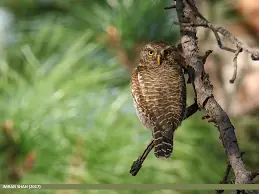
They are most common in the Himalayas and the Terai. They lay their eggs in February, March, and April; and both parents incubate the eggs for 22 days. They feed mainly on insects but also on fruit.
Asian Brown Flycatcher
Asian Brown Flycatchers are sometimes considered to be the same species as the Spotted Flycatcher. However, they have different songs and styles, and have different ranges. Asian Brown Flycatchers inhabit China, Thailand, Burma, Cambodia, Laos, and Peninsular Malaysia. They are typically found in lowland forests, and near streams or lakes. They build small nests out of leaves and twigs, and lay three eggs. Both parents incubate the eggs for 15 days.
Asian Desert Sparrow
Asian Desert Sparrows are mostly found on the Indian subcontinent and nearby islands. Their habitats include dry scrub, grasslands, and arid mountains. They build nests of straw and plant fibers, and lay three to five eggs. Both parents incubate the eggs for 14 to 16 days. Their diet consists of insects, seeds, and berries.
Asian Dowitcher
Asian Dowitchers breed in Siberia, China, Mongolia, and Korea, and winter mainly on the Pacific coast of Asia. They nest in shallow wetlands and marshes, and lay three eggs. Both parents incubate for 15 to 17 days. Their diet consists of insects, snails, frogs, and fish.
Asian Emerald Cuckoo
Asian Emerald Cuckoos breed in parts of China, India, Southeast Asia, and Papua New Guinea. They nest in tall trees and bushes, and lay two to three eggs. Both parents incubate for 14 to 16 days. They feed on insects, spiders, and caterpillars, and are also known to be cannibalistic.
Asian Fairy-bluebird
This species is found in the forests of Myanmar. It is a fairly small bird, 14cm long and weighing 12 grams. The male has a blue-grey head, chest, abdomen and tail, while the back is black with metallic green-blue spots. The female has similar plumage, but less blue tones. The call is a loud “chick-chick”. This is a common bird in suitable rainforest habitat, where it builds its nest in a tree, often near a water source.
Asian Glossy Starling
The Asian Glossy Starling (Sturnus malabaricus) is a small passerine bird in the starling family. It breeds in southeast Asia from the Himalayas east to central China, and south to Indonesia. The species is a part of the sturnid species complex, which ranges south through the Moluccas (and New Caledonia) to northern Australia.
Asian Golden-Weaver
This weaver species is found in South and Southeast Asia, northern Australia, and the Andaman Islands. In northern Australia, it has been recorded from Cape York Peninsula, the Top End of the Northern Territory, and northern Western Australia. Outside the breeding season, this bird can be found in a wide range of habitats, but usually near water. It builds a nest made of grass and leaves, often in a clearing, and lays 2-3 eggs.
Asian House-Martin
The Asian house martin is a small passerine bird in the swallow family. It breeds in southeast Asia, from India east to the Philippines, Indonesia, and southeast China. This species is migratory, wintering in tropical southern Asia, north India, and southeast Asia. It nests in colonies, building mud nests in buildings or cliffs, and laying 2-4 white eggs.
Asian Koel
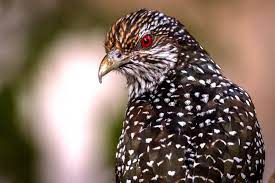
The Asian koel is a species of bird in the family Estrildidae. It is found in Brunei, Cambodia, China, Hong Kong, India, Indonesia, Laos, Malaysia, Myanmar, Nepal, Singapore, Thailand, and Vietnam. Its natural habitat is subtropical or tropical moist lowland forests.
Asian Openbill
This bird is found in China, Taiwan, and Hong Kong. It is found in lowland evergreen forests and orchards.
Asian Palm-Swift
The Asian palm-swift is found in open areas, from Sri Lanka to Burma and Thailand. Its natural habitats are subtropical or tropical moist lowland forests and subtropical or tropical moist montane forests.
Asian Paradise-Flycatcher
The Asian paradise-flycatcher is a bird of paradise native to Indonesia, Malaysia, and the Philippines, where its range extends from Palawan east to Sulawesi.
Asian Pied Starling
This species is found in forest and secondary growth. It feeds on fruit, insects and nectar. It is associated with mangrove swamps and estuaries.
Asian Rosy-Finch
Asian Rosyfinch is native to eastern and southern Asia, and is found on Borneo, Java, Sumatra, and Sulawesi. It is mainly a lowland species, but in some parts of its range it can also be found up to elevations of 1,000 meters.
Asian Short-toed Lark
Asian Short-toed Lark is a chat-voiced species of lark. It has short, rounded wings, a long, pendulous tail, a rounded head and a dark cap. The male is glossy blue-grey above and duller below, with a rufous tinge on the forehead. It has a white rump and pale grey underparts. The female is much duller, with brownish wings, and pale grey underparts.
Atherton Scrubwren
Atherton Scrubwren is a tiny passerine bird in the scrubwren family, Serrawadeidae. It is monotypic within the genus Atherton.
Athi Short-toed Lark
The Athi short-toed lark is a small passerine bird in the Alaudidae family. It has grey-brown upperparts, pale underparts with brown streaks, and a pale brown eye. Its legs are short and pinkish-grey. The sexes are similar in size and coloration.
Atitlan Grebe
The Atitlan grebe is a medium-sized grebe. It has a blue-grey head and neck, white underparts, blackish legs, a black bill and a blackish eye. It is black on its back and wings, with a white bar on its back and a white patch on its wing.
Atiu Swiftlet
Atiu Swiftlets are very small birds, about 7-9cm in length and 12-14g in weight. They have a slender, longish, pointed, black bill. The eyes are brown with a pale iris. The plumage is dark-brown above and dark grey-brown below the rump, becoming white on the belly and undertail coverts. The wings are dark brown with pale brown tips and have two pale wingbars. The legs and feet are dark grey-brown.
Atlantic Petrel
The Atlantic petrel or wandering petrel is a small seabird of the genus Pterodroma, one of the smallest seabird genera in the world. The Atlantic petrel breeds on the tropical Atlantic and Indian coasts. Its range extends from western Europe and Africa to east Asia, including Hawaii.
Atlantic Puffin
Puffins are seabirds of the family Procellariidae. They are found worldwide, mostly in cold ocean waters, but with some species inhabiting tropical seas. The puffin’s diet consists of small fish, crustaceans, and cephalopods. Puffins nest on the ground on cliffs.
Atlantic Royal Flycatcher
The Atlantic Royal Flycatcher is a common, medium-sized, tropical passerine bird. Its plumage is gray-brown above and white below. There is a black crown with a yellow band. The wings are brown with yellow fringes. The tail is blackish with a broad yellow band. The bill is yellow on the upper mandible and black on the under mandible.
Atoll Fruit-Dove
The atoll fruit- dove is a species of bird in the family Columbidae. It is found in the tropical and subtropical Pacific and Indian Oceans. Its natural habitats are subtropical or tropical mangrove forests and subtropical or tropical moist lowland forests.
Atoll Starling
The atoll starling is a species of bird in the family Sturnidae. It is endemic to the islands of French Polynesia, where it is found on the atolls Tupai, Pao Pao, and Tahiti. Its natural habitats are subtropical or tropical dry forest and subtropical or tropical moist lowland forest.
Auckland Islands Merganser
The Auckland Island Merganser (Mergus australis) is a sea duck endemic to the Auckland Islands of New Zealand. It is the only bird species endemic to the Auckland Islands and one of two endemic land birds there, the other being the Auckland Islands Robin.
Auckland Islands Rail
The Auckland Island Rail or Kakapo (Rallus exsul) is an endangered flightless rail endemic to the Auckland Islands of New Zealand. It is the largest parrot in the world (the largest living parrot).
Auckland Islands Shag
The Auckland Island Shag or Tonga, is a large, white-plumaged gannet, found only in the Auckland Islands, New Zealand.
Audouin’s Gull
The Audouin’s Gull (Larus audouinii) is a large gull that breeds in Arctic Europe and Asia Minor. It is migratory, wintering from Iceland or the West Spitsbergen to Asia. Birds from Iceland and Spitsbergen are larger on average than those from Europe and Asia Minor. It is named for the French naturalist Jules Pierre Antoine Audouin.
Audubon’s Oriole
The Audubon’s Oriole is a medium sized oriole with a length of 11.5 to 14 cm (4.5 to 5.5 in) and a wingspan of 29.5 to 32.5 cm (11.5 to 12.7 in). The adult male has a black head and back, yellow throat, breast, and belly, white undertail coverts and orange-red rump. The female is olive-brown above with pale grey underparts. It has a black bill, yellow legs and a short black crest.
Audubon’s Shearwater
The Audubon’s Shearwater is a medium-sized shearwater, 38 to 43 cm (15 to 17 in) long, with a wingspan of 97 to 116 cm (38 to 46 in). The adult female has a white forehead, black cap, blue-grey upperparts, and white underparts.
The rump is blackish with narrow white spots, and the underwing coverts are white. The tail is blackish with narrow white bands.
The adult male is similar; however, the forehead is black, the cap is dark bluish-grey, and the upperparts are more purplish. The underparts are white, and the throat, breast, and belly are yellow. The rump is black, with white spots. The tail is black, with white bands.
Augur Buzzard
The Augur Buzzard is a medium-large raptor, 54 to 57 cm (21 to 22 in) long, with a wingspan of 113 to 120 cm (44 to 47 in). It has a pale grey head, nape, upperparts and rump.
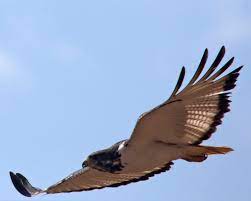
The underparts are whitish, heavily streaked with black, and the wings and tail are barred with darker grey and black. The bill is pale grey, and the legs are dark grey. The female is similar, but the head is scaled and spotted with light brown, and the tail is barred with white. The juvenile is similar to the female.
Austen’s Brown Hornbill
The Austen’s Brown Hornbill is a medium-large hornbill, 38 to 43 cm (15 to 17 in) long, with a wingspan of 97 to 116 cm (38 to 46 in). The adult has a brown head with a pale rufous stripe from eye to ear, a brown nape, and rufous upperparts. The underparts are white. The tail is black, with narrow white bars. The female is similar, but the head is scaled and spotted with light brown.
Austral Blackbird
The Austral Blackbird is a large blackbird, 56 to 63 cm (22 to 25 in) long with a wingspan of 120 to 130 cm (47 to 51 in). The male is distinctive, with a glossy black head, neck and breast, dark blue upperparts, red-brown wings and a rufous belly. The wings are edged with paler feathers. The female is paler, with less glossy black on the throat, and with a brown nape.
Austral Canastero
The Austral Canastero is endemic to the island of Santiago, Chile. It is a large, dark-plumaged and mostly black canastero with a long tail and a white eyering. The feathers of the belly and breast are pale grey, and the flight feathers are black.
Austral Parakeet
The Austral Parakeet is endemic to the island of Santiago, Chile. It is a mostly green parakeet with a long tail, white eye-ring, and yellow feet. The anal feathers are blue, and the flight feathers are black. The male is green with the lowerparts green and the upperparts olive-grey. The female is olive-grey below with a green back and wings. Juveniles are duller green.
Austral Pygmy-Owl
The Pygmy-Owl is a very small owl, measuring 16-17cm. and weighing 22-25g. It is found throughout Australia in scrubby habitats, often near watercourses, including around urban areas. The Austral Pygmy-Owl is a nocturnal resident, and feeds on insects, small mammals, reptiles and small birds. It nests in hollows in trees.
Austral Rail
The Austral Rail is found throughout Australia, although it is most abundant in Tasmania. This rail lives in the scrubby habitat, often near watercourses, including around urban areas. The Austral Rail is a nocturnal resident, and feeds on insects, small mammals, reptiles and small birds. It nests in hollows in trees.
Austral Screech-Owl
The Austral Screech-Owl has a very large range, and is common in most of Tasmania. It is found in large numbers in forests and woodlands, and feeds on insects, small mammals, reptiles and small birds. The Austral Screech-Owl is very vocal, with loud, screechy calls. It nests in hollows in trees.
Austral Thrush
The Austral Thrush has a very large range, and is common in most of Tasmania. It is found in large numbers in forests and woodlands, and feeds on insects, small mammals, reptiles and small birds. The Austral Thrush is very vocal, with loud, raspy calls. It nests in hollows in trees.
Australasian Bittern
This large heron has a very large range, and is common in most of Tasmania. It is found in large numbers in forests and woodlands, and feeds on insects, small mammals, reptiles and small birds. The Australasian Bittern is very vocal, with loud, croaking calls. It nests in hollows in trees.
Australasian Gannet
The Australasian Gannet has a very large range, and is common in most of Tasmania. It is found in large numbers in coastal and estuarine waters, and feeds on fish. The Australasian Gannet is very vocal, with loud, booming sounds.
Australasian Grebe
This species is found in freshwater lakes, reservoirs, and rivers in Australia. It is a diving bird that feeds on small fish, frogs, crustaceans, aquatic worms and other invertebrates. It nests among aquatic vegetation, usually near the shore.
Australasian Lark
The Australasian Lark is a medium-sized lark of the genus Alauda. It breeds in Australia and New Guinea, and migrates to Indonesia, the Philippines and Micronesia.
Australasian Pipit
The Australasian Pipit is a small passerine bird. The sexes are similar in tone but distinct in plumage. The head and upperparts are grey-brown, the underparts are pale grey, and the undertail and rump are white.
There is usually a white supercilium, which becomes broader behind the eye. The eye is dark brown. The short wings are dark with grey wingtips, and the beak and legs are black.
Australian Brush-turkey
This bird is found in mainland Australia. It feeds on seeds, grass and other vegetation. Like many species, it forms flocks outside of breeding season.
Australian Bustard
This bird is found in mainland Australia. Its long legs enable it to run quickly, and its head is held low to the ground enabling it to see predators. The species feeds on seeds and grass.
Australian Crake
This bird is found in mainland Australia. It is nocturnal and feeds on invertebrates such as insects and snails.
Australian Darter
The Australasian Darter (Anhinga novaehollandiae), also known as the Australasian Snakebird or Snakebird, is a medium-sized bird of prey in the snake family. It breeds in Australia and New Guinea, and is migratory, wintering in southern New Guinea and Indonesia.
It is distinctive in appearance, with a long thin neck, long narrow wings and tail, and very long legs. Its plumage is cryptic, being mostly black, brown, grey and white. The colouration is patterned, especially on the head, and varies with age.
Australian Hobby
The Australian hobby (Falco longipennis), also known as the blue-capped or blue-browed hobby, is a bird of prey in the family Falconidae. The species is endemic to Australia. The hobby is 58–70 cm long with a 120–140 cm wingspan, and has distinctive, long, broad wings and long tail. The male has a blue head and white underparts, the female a brown head with pale underparts. The hobby has a fast direct flight and soars high in the air with its broad wings outstretched.
Australian Ibis
The ibis (Threskiornis moluccus) is a very large, long-legged wading bird. The ibis is found over most of Eurasia and Africa, and in Australia, and New Zealand to Pacific Islands. There are 15 species and one subspecies of Ibis including the Australian Ibis..
The ibis is a distinctive bird with long legs and a long neck. The male has glossy black plumage, and the female black, grey and white plumage. The bill is straight and pointed, and the legs are long.
Australian King-Parrot
The Australian king-parrot (Alisterus scapularis) is a very large parrot that is native to Australia. It is commonly named for its large size, distinctive yellow head, and red forehead. It is the national bird of Australia.
The species is highly variable in colouration. The plumage can be green, blue, grey, brown, and even black. The adult males have a bright yellow head, green upperparts, and a red forehead. The underparts are blue-grey and the rump is yellow. The females are olive green, duller above and yellow below.
Australian Koel
The Australian koel (Eudynamys scolopacea) is a species of cuckoo in the family Cuculidae. It is endemic to Australia and inhabits open forest, farmlands, and rainforests. The koel is a mid-sized cuckoo at 27–29 cm in length with a 55–60 cm wingspan.
The koel has distinctive black, red and yellow plumage. The head, neck and upperparts of the adult koel are black. The underparts of the adult koel are yellow. The wings have broad black margins and the flight feathers are edged in yellow. The tail is black, with broad yellow tips.
Australian Magpie
The Australian Magpie is a medium-sized omnipresent well known garden bird with a wingspan of around 30 inches. It is generally a grey-brown bird, although it can vary from pale grey to blackish brown, and has white markings on its back.
It has a large rounded head, a long tail, and a strong hooked beak. The sexes are similar in appearance. Juveniles have greyish-brown plumage and paler underparts, and lack the distinctive black-and-white barred back.
The Australian Magpie’s strong bill and claws excel at breaking open nuts, and it often feeds on nuts as well as insects. It is nomadic, moving seasonally and between states.
Australian Masked-Owl or Masked Owl
It breeds from near Adelaide to southern Queensland, and is nomadic outside the breeding season, often moving between states. It prefers semi-arid to arid landscapes, often in areas with scattered trees. It nests in hollow trees, often using dead trees, and lays 2-4 white eggs.
Australian Owlet-Nightjar
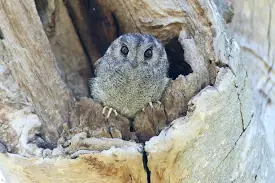
It roosts by day in hollow trees, and emerges at dusk to feed on insects. The nesting habits are not well known.
Australian Pelican
The adult birds of this large aquatic bird have a distinctive blue-grey plumage. The neck is grey with a pinkish tinge, while the back is blue-grey with a darker, greenish tinge. The wings are white with black flight feathers, and the underparts are mostly white. The head has a pinkish tinge, a rounded forehead, a pale bluish-grey bill and a yellow-orange or orange-yellow eye. The juvenile birds have a browner plumage, lacking the blue-grey tinge of the adults. The bill is grey.
Australian Pratincole
The adult birds of this bird show no sexual dimorphism, since the male and female have the same plumage. The adult birds are blackish-brown above, with paler brown underparts. The head has a greenish tinge, and its eyes are reddish brown. They have a long pointed wings and a long pointed tail. The juvenile birds are similar to the adults, but with a blackish-brown head.
Australian Raven
The adult bird of the raven has a blackish-brown plumage, with a white throat, a grey bill, and reddish eyes. The juvenile birds are similar to the adults, but with a blackish-brown head.
Australian Reed-Warbler
This bird is found throughout Australia, and is the only member of the genus Acrocephalus. It lives in reed-beds, swamps, and lakes, eating insects, worms, and seeds. Their bright colours are a warning to predators.
Australian Shelduck
The Australian Shelducks are found in inland and coastal marine waters, including estuaries. It is migratory, but wintering birds often remain near breeding areas. It is gregarious, and at night forms large flocks. In Australia it breeds from August to January. In New Zealand, it breeds from July to January.
Australian Shoveler
The Australian shoveler (Anas clypeata) is a large dabbling duck that breeds across northern and eastern Australia, and in southern New Guinea. It is migratory, wintering in coastal Australia. It is gregarious outside the breeding season, forming large flocks. It feeds on plant matter, as well as invertebrates and crustaceans, and molluscs.
Australian Swiftlet
The Australian Swiftlet (Aerodramus fuciphagus) is a species of swift in the family Apodidae. It is found in southern and eastern Australia, and Tasmania. Its natural habitats are subtropical or tropical moist lowland forest and subtropical or tropical mangrove forest.
Australian Yellow White-eye
The Australian yellow white-eye (Zosterops australis) is a species of bird in the family Zosteropidae. It is found in south-eastern Australia. Its natural habitats are subtropical or tropical mangrove forests and subtropical or tropical dry shrubland.
Australian or Nankeen Kestrel
This bird was described in 1827 from a specimen collected in South Australia. It breeds from central Australia to eastern Australia, and on Tasmania and King Island. It is a large raptor, about the same size as the Peregrine Falcon, but has a long tail and black-tipped wings. It hunts for insects by hovering and darting at insects or small reptiles, or pouncing on prey from the ground.
Australian or Port Lincoln Ringneck
Ringnecks are passerine birds belonging to the family Psittacidae . The males are brightly coloured with elaborate patterns and the females are generally duller. Members of this genus have large heads, short thick necks, short stout bills and long, often pointed wings.
Ayres’s Hawk-Eagle
This species is endemic to the Galápagos Islands, where it is found on all four islands. The sexes are similar. Ayres’s Hawk-Eagle is 30-38 cm long and weighs 600-1000 grams. It has a sharp pointed bill and long narrow wings. The upperparts are blue-gray, while the underparts are white. The flight is strong and direct.
Azara’s Spinetail
The Azara’s Spinetail is a species of bird in the family Furnariidae . It is found in the southernmost Amazon Basin in southern Colombia, eastern Ecuador and northwestern Peru. Its natural habitats are subtropical or tropical moist lowland forests and heavily degraded former forest.
Azores Bullfinch
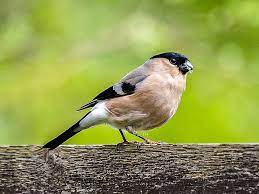
The Azores Bullfinch (Pyrrhula murina) is a passerine bird in the finch family Fringillidae . It breeds on the Azores and on islands off the west coast of North Africa.
Aztec Parakeet
The Aztec Parakeet (Aratinga astrild) is a species of parrot in the family Psittacidae . It is endemic to Mexico and is little known. The Aztec Parakeet is named for its occurrence in the Aztec Empire where it was kept as a pet.
Aztec Thrush
The Aztec Thrush is a resident breeding bird from central Mexico south to central Costa Rica. It is a widespread species, being found from sea level to up to about 2000 metres, and is found both in humid forest and in more open habitats, including forest edge, humid forest clearings and roadsides. It occurs in both deciduous and evergreen forest, and in secondary forest.
Azure Gallinule
This small white gallinule frequently is found in flocks. It feeds on aquatic insects and small crustaceans. It often utters a shrill ki-ki-ki-ki call.
Azure Jay
The Azure Jay is found in the southwestern United States, south through Mexico and Central America to northern Argentina. Its habitat is woodland and forest, especially in areas with sycamore or oak trees and fruiting trees such as palms, figs, and citrus trees.
Azure Kingfisher
The Azure Kingfisher is found on the Pacific coast in tropical Mexico. Its diet consists of small fish and other aquatic animals, which it catches by diving from a high perch.
Azure Tit
The Azure Tit is found in Bolivia, Colombia, Ecuador, Peru, and Venezuela, and on Trinidad. Its habitat is subtropical and tropical moist montane forest.
Azure-breasted Pitta
The Azure-breasted Pitta is an uncommon bird in the highlands of New Guinea. It feeds on insects and small invertebrates, which it catches mainly on the ground.
Azure-crown Hummingbird
This tiny nectar eater is found in clearings, woodlands, and the edges of forests in the eastern and southern parts of South America. It mainly feeds on flowers of the genus Heliconia (Heliconiaceae).
Azure-hooded Jay
The Azure-hooded Jay shows white underparts, dark wings and a narrow tail. The distinctive feature is a crest of blue feathers on top its head and a black mask around the eyes.
Azure-naped Jay
The Azure-naped Jay is found from southern Mexico to northern Argentina. It is a large jay, with reddish-brown upperparts, white underparts, and a mostly black tail. The male has a black crest, the female has a crest that is either white or yellowish-white.
Azure-rumped Tanager
The Azure-rumped Tanager (Thraupis azurea) is a species of passerine bird in the Thraupidae family. It breeds from Costa Rica to western Panama, Colombia, eastern Ecuador and far northern Peru. It migrates south across central Venezuela to western Colombia, northwestern Ecuador and northwestern Peru. Its natural habitats are subtropical or tropical moist montane forests and heavily degraded former forest.
Azure-rumped or Blue-backed Parrot
The azure-rumped or blue-backed parrot (Psittacara melacara) is a species of parrot in the family Psittacidae. It is found in Colombia, Ecuador, and Peru. Its natural habitat is subtropical or tropical moist montane forests. It is named after its distinctive blue back.
Azure-shouldered Tanager
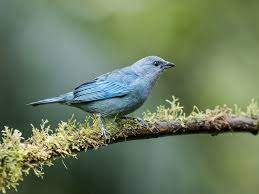
The Azure-shouldered Tanager (Amazilia cyanomelana) is a species of bird in the make certain family Thraupidae. It is found in Colombia and Ecuador. Its natural habitat is subtropical or tropical moist montane forests.
Azure-winged Magpie
The Azure-winged Magpie (Cyanopica cyana) is a species of bird in the Corvidae family. It is found in Colombia, Ecuador, and Venezuela. Its natural habitat is subtropical or tropical moist montane forests. It eats the same diet as most other magpies.
All birds starting with an A listed by length
I have made a table listing all the birds starting with an A below. They are sorted by length and the number of characters in the birds name is shown in the right column.
| Bird | Number of Letters |
| Akepa | 5 |
| Amaui | 5 |
| Akekee | 6 |
| Akialoa | 7 |
| Anhinga | 7 |
| Apapane | 7 |
| Anianiau | 8 |
| Apo Myna | 8 |
| Ashy Tit | 8 |
| Akohekohe | 9 |
| Azure Jay | 9 |
| Azure Tit | 9 |
| Akiapolaau | 10 |
| Ash’s Lark | 10 |
| Afep Pigeon | 11 |
| Amur Falcon | 11 |
| Andean Duck | 11 |
| Andean Guan | 11 |
| Andean Gull | 11 |
| Andean Ibis | 11 |
| Angola Lark | 11 |
| Apo Sunbird | 11 |
| Apostlebird | 11 |
| Arctic Loon | 11 |
| Arctic Tern | 11 |
| Ashy Bulbul | 11 |
| Ashy Drongo | 11 |
| Ashy Prinia | 11 |
| Ashy Thrush | 11 |
| African Baza | 12 |
| Alpine Munia | 12 |
| Alpine Pipit | 12 |
| Alpine Robin | 12 |
| Alpine Swift | 12 |
| Amami Thrush | 12 |
| Andean Goose | 12 |
| Andean Potoo | 12 |
| Andean Snipe | 12 |
| Andean Swift | 12 |
| Angola Batis | 12 |
| Ashy Minivet | 12 |
| Austral Rail | 12 |
| Aztec Thrush | 12 |
| Abdim’s Stork | 13 |
| African Crake | 13 |
| African Hobby | 13 |
| African Pipit | 13 |
| African Pitta | 13 |
| African Snipe | 13 |
| African Swift | 13 |
| Alaotra Grebe | 13 |
| Aleutian Tern | 13 |
| Amani Sunbird | 13 |
| American Coot | 13 |
| American Crow | 13 |
| Andaman Crake | 13 |
| Andean Avocet | 13 |
| Andean Condor | 13 |
| Andean Siskin | 13 |
| Andean Tyrant | 13 |
| Ankober Serin | 13 |
| Archer’s Lark | 13 |
| Armenian Gull | 13 |
| Ashy Myzomela | 13 |
| Ashy Starling | 13 |
| Atitlan Grebe | 13 |
| Atiu Swiftlet | 13 |
| Augur Buzzard | 13 |
| Abbott’s Booby | 14 |
| Abert’s Towhee | 14 |
| Abyssinian Owl | 14 |
| Adelie Penguin | 14 |
| African Citril | 14 |
| African Cuckoo | 14 |
| African Darter | 14 |
| African Hoopoe | 14 |
| African Jacana | 14 |
| African Thrush | 14 |
| Akun Eagle-Owl | 14 |
| Aldabra Drongo | 14 |
| Altai Snowcock | 14 |
| Amami Woodcock | 14 |
| American Robin | 14 |
| Andaman Drongo | 14 |
| Andean Emerald | 14 |
| Andean Flicker | 14 |
| Andean Lapwing | 14 |
| Andean Negrito | 14 |
| Andean Swallow | 14 |
| Andean Tinamou | 14 |
| Angola Babbler | 14 |
| Angola Swallow | 14 |
| Antarctic Shag | 14 |
| Antarctic Tern | 14 |
| Antillean Wren | 14 |
| Arctic Warbler | 14 |
| Arfak Astrapia | 14 |
| Ashy Cisticola | 14 |
| Ashy-faced Owl | 14 |
| Asian Openbill | 14 |
| Asian Stubtail | 14 |
| Atoll Starling | 14 |
| Audouin’s Gull | 14 |
| Austral Thrush | 14 |
| Aztec Parakeet | 14 |
| Abyssinian Lark | 15 |
| African Finfoot | 15 |
| African Goshawk | 15 |
| African Piculet | 15 |
| African Skimmer | 15 |
| Alagoas Antwren | 15 |
| Albertine Owlet | 15 |
| Alpine Accentor | 15 |
| Altamira Oriole | 15 |
| American Avocet | 15 |
| American Dipper | 15 |
| American Wigeon | 15 |
| Anambra Waxbill | 15 |
| Ancash Tapaculo | 15 |
| Andaman Treepie | 15 |
| Andean Flamingo | 15 |
| Andean Hillstar | 15 |
| Andean Parakeet | 15 |
| Andean Tapaculo | 15 |
| Anjouan Sunbird | 15 |
| Annam Partridge | 15 |
| Antarctic Prion | 15 |
| Antillean Mango | 15 |
| Aplomado Falcon | 15 |
| Apolinar’s Wren | 15 |
| Aquatic Warbler | 15 |
| Arabian Babbler | 15 |
| Arabian Bustard | 15 |
| Arabian Waxbill | 15 |
| Ashy Flycatcher | 15 |
| Ashy Tailorbird | 15 |
| Ashy Woodpecker | 15 |
| Asian Dowitcher | 15 |
| Atlantic Petrel | 15 |
| Atlantic Puffin | 15 |
| Australian Ibis | 15 |
| Australian Koel | 15 |
| Azure Gallinule | 15 |
| Azure-naped Jay | 15 |
| Abbott’s Babbler | 16 |
| Acorn Woodpecker | 16 |
| Adalbert’s Eagle | 16 |
| Afghan Snowfinch | 16 |
| African Blue Tit | 16 |
| African Openbill | 16 |
| African Wood-Owl | 16 |
| Agile Tit-Tyrant | 16 |
| Ahanta Francolin | 16 |
| Alagoas Curassow | 16 |
| Alder Flycatcher | 16 |
| American Bittern | 16 |
| American Kestrel | 16 |
| Amethyst Sunbird | 16 |
| Ancient Murrelet | 16 |
| Andean Pygmy-Owl | 16 |
| Andean Solitaire | 16 |
| Angola Cave-Chat | 16 |
| Angola Cisticola | 16 |
| Antarctic Petrel | 16 |
| Antillean Siskin | 16 |
| Arabian Wheatear | 16 |
| Archer’s Buzzard | 16 |
| Arfak Honeyeater | 16 |
| Ashy Wood-Pigeon | 16 |
| Ashy Woodswallow | 16 |
| Asian Palm-Swift | 16 |
| Asian Rosy-Finch | 16 |
| Atoll Fruit-Dove | 16 |
| Audubon’s Oriole | 16 |
| Austral Parakeet | 16 |
| Australian Crake | 16 |
| Australian Hobby | 16 |
| Australian Raven | 16 |
| Azores Bullfinch | 16 |
| Azure Kingfisher | 16 |
| Azure-hooded Jay | 16 |
| Abbott’s Starling | 17 |
| Abyssinian Roller | 17 |
| Abyssinian Siskin | 17 |
| African Broadbill | 17 |
| African Firefinch | 17 |
| African Scops-Owl | 17 |
| African Spoonbill | 17 |
| African Stonechat | 17 |
| Ala Shan Redstart | 17 |
| Albert’s Lyrebird | 17 |
| Alexander’s Swift | 17 |
| Allen’s Gallinule | 17 |
| Amazon Kingfisher | 17 |
| American Redstart | 17 |
| American Woodcock | 17 |
| Amethyst Woodstar | 17 |
| Anchieta’s Barbet | 17 |
| Andaman Scops-Owl | 17 |
| Anjouan Scops-Owl | 17 |
| Annobon White-eye | 17 |
| Antillean Piculet | 17 |
| Apical Flycatcher | 17 |
| Appert’s Greenbul | 17 |
| Arabian Partridge | 17 |
| Arrowhead Warbler | 17 |
| Ashy Cuckooshrike | 17 |
| Ashy Flowerpecker | 17 |
| Ashy Storm-Petrel | 17 |
| Ashy-headed Goose | 17 |
| Ashy-tailed Swift | 17 |
| Austral Blackbird | 17 |
| Austral Canastero | 17 |
| Austral Pygmy-Owl | 17 |
| Australasian Lark | 17 |
| Australian Darter | 17 |
| Australian Magpie | 17 |
| Azara’s Spinetail | 17 |
| Aberdare Cisticola | 18 |
| Abyssinian Catbird | 18 |
| Abyssinian Waxbill | 18 |
| Acadian Flycatcher | 18 |
| Adelaide’s Warbler | 18 |
| African Black Duck | 18 |
| African Fish-Eagle | 18 |
| African Hawk-Eagle | 18 |
| African Palm-Swift | 18 |
| African Quailfinch | 18 |
| African Silverbill | 18 |
| African Tailorbird | 18 |
| Alagoas Tyrannulet | 18 |
| Alexander’s Akalat | 18 |
| Amazonian Antpitta | 18 |
| Amchitka Cormorant | 18 |
| American Goldfinch | 18 |
| Anchieta’s Sunbird | 18 |
| Andaman Woodpecker | 18 |
| Anna’s Hummingbird | 18 |
| Ansorge’s Greenbul | 18 |
| Antillean Euphonia | 18 |
| Antipodes Parakeet | 18 |
| Apurimac Spinetail | 18 |
| Arabian Woodpecker | 18 |
| Ash-colored Cuckoo | 18 |
| Ash-throated Crake | 18 |
| Ash-winged Antwren | 18 |
| Asian Barred Owlet | 18 |
| Asian House-Martin | 18 |
| Atherton Scrubwren | 18 |
| Australasian Grebe | 18 |
| Australasian Pipit | 18 |
| Australian Bustard | 18 |
| Australian Pelican | 18 |
| Ayres’s Hawk-Eagle | 18 |
| Abyssinian Longclaw | 19 |
| Adamawa Turtle-Dove | 19 |
| African Pygmy-goose | 19 |
| Allen’s Hummingbird | 19 |
| Amazonian Antshrike | 19 |
| Amazonian Parrotlet | 19 |
| American Black Duck | 19 |
| Amethyst Brown-Dove | 19 |
| Andaman Cuckoo-Dove | 19 |
| Andaman Wood-Pigeon | 19 |
| Andean Slaty-Thrush | 19 |
| Antillean Nighthawk | 19 |
| Archbold’s Newtonia | 19 |
| Archer’s Robin-Chat | 19 |
| Ashy-headed Babbler | 19 |
| Asian Golden-Weaver | 19 |
| Asian Pied Starling | 19 |
| Austral Screech-Owl | 19 |
| Australasian Gannet | 19 |
| Australian Shelduck | 19 |
| Australian Shoveler | 19 |
| Australian Swiftlet | 19 |
| Azure-winged Magpie | 19 |
| African Barred Owlet | 20 |
| African Bush-Warbler | 20 |
| African Green-Pigeon | 20 |
| African Olive-Pigeon | 20 |
| African Pied Wagtail | 20 |
| African Reed-Warbler | 20 |
| African River-Martin | 20 |
| Alexandrine Parakeet | 20 |
| Amazilia Hummingbird | 20 |
| Amazonian Oropendola | 20 |
| Andean Tit-Spinetail | 20 |
| Antillean Palm-Swift | 20 |
| Archbold’s Bowerbird | 20 |
| Arrow-marked Babbler | 20 |
| Ash-breasted Antbird | 20 |
| Ash-browed Spinetail | 20 |
| Ash-colored Tapaculo | 20 |
| Ash-throated Antwren | 20 |
| Ash-throated Warbler | 20 |
| Ashy-headed Greenlet | 20 |
| Asian Desert Sparrow | 20 |
| Asian Emerald Cuckoo | 20 |
| Asian Fairy-bluebird | 20 |
| Athi Short-toed Lark | 20 |
| Audubon’s Shearwater | 20 |
| Australasian Bittern | 20 |
| Azure-breasted Pitta | 20 |
| Azure-rumped Tanager | 20 |
| Aberrant Bush-Warbler | 21 |
| Abyssinian Woodpecker | 21 |
| African Collared-Dove | 21 |
| African Golden-Oriole | 21 |
| African Golden-Weaver | 21 |
| African Grey Hornbill | 21 |
| African Marsh-Harrier | 21 |
| African Oystercatcher | 21 |
| African Penduline-Tit | 21 |
| African Pied Hornbill | 21 |
| African Pied Starling | 21 |
| African Scrub-Warbler | 21 |
| Aldabra Brush-Warbler | 21 |
| Altamira Yellowthroat | 21 |
| American Tree Sparrow | 21 |
| Andaman Serpent-Eagle | 21 |
| Anjouan Brush-Warbler | 21 |
| Ascension Frigatebird | 21 |
| Asian Glossy Starling | 21 |
| Asian Short-toed Lark | 21 |
| Auckland Islands Rail | 21 |
| Auckland Islands Shag | 21 |
| Australian Pratincole | 21 |
| African Emerald Cuckoo | 22 |
| Amazonian Black-Tyrant | 22 |
| Amazonian Umbrellabird | 22 |
| Ambon Yellow White-eye | 22 |
| American Golden-Plover | 22 |
| American Oystercatcher | 22 |
| American Painted-snipe | 22 |
| American White Pelican | 22 |
| Arabian Golden-Sparrow | 22 |
| Ash-throated Casiornis | 22 |
| Ash-throated Gnateater | 22 |
| Ashy-headed Tyrannulet | 22 |
| Asian Brown Flycatcher | 22 |
| Australian King-Parrot | 22 |
| Abyssinian Crimson-wing | 23 |
| Abyssinian Hill-Babbler | 23 |
| African Blue-Flycatcher | 23 |
| Alagoas Foliage-gleaner | 23 |
| Andean Cock-of-the-rock | 23 |
| Angola Slaty-Flycatcher | 23 |
| Araucaria Tit-Spinetail | 23 |
| Ash-breasted Tit-Tyrant | 23 |
| Ash-throated Flycatcher | 23 |
| Austen’s Brown Hornbill | 23 |
| Australian Brush-turkey | 23 |
| Australian Reed-Warbler | 23 |
| Abyssinian Ground-Thrush | 24 |
| Abyssinian Scimitar-bill | 24 |
| African Dusky Flycatcher | 24 |
| African Pygmy-Kingfisher | 24 |
| African Yellow White-eye | 24 |
| Akikiki or Kauai Creeper | 24 |
| American Mountain Thrush | 24 |
| Antioquia Bristle-Tyrant | 24 |
| Apricot-breasted Sunbird | 24 |
| Ashy-breasted Flycatcher | 24 |
| Ashy-throated Parrotbill | 24 |
| Azure-shouldered Tanager | 24 |
| African Forest-Flycatcher | 25 |
| African Shrike-flycatcher | 25 |
| American Pygmy Kingfisher | 25 |
| Archbold’s Owlet-Nightjar | 25 |
| Ash-breasted Sierra-Finch | 25 |
| Ashy-crowned Sparrow-Lark | 25 |
| Asian Koel or Common Koel | 25 |
| Asian Paradise-Flycatcher | 25 |
| Atlantic Royal Flycatcher | 25 |
| Australian Owlet-Nightjar | 25 |
| Azure-crowned Hummingbird | 25 |
| Abyssinian Grosbeak-Canary | 26 |
| African Crested-Flycatcher | 26 |
| Amazonian Scrub-Flycatcher | 26 |
| Amethyst-throated Sunangel | 26 |
| Amsterdam Island Albatross | 26 |
| Ashy-headed Laughingthrush | 26 |
| Ashy-throated Bush-Tanager | 26 |
| Auckland Islands Merganser | 26 |
| Abyssinian Slaty-Flycatcher | 27 |
| African Black-headed Oriole | 27 |
| African Paradise-Flycatcher | 27 |
| Annobon Paradise-Flycatcher | 27 |
| Australian Yellow White-eye | 27 |
| Amethyst-throated Hummingbird | 29 |
| Angola or Gabela Helmetshrike | 29 |
| Antillean Crested Hummingbird | 29 |
| Australian or Nankeen Kestrel | 29 |
| African Grass-Owl or Grass Owl | 30 |
| Alexandra’s or Princess Parrot | 30 |
| American Harrier or Marsh Hawk | 30 |
| American Three-toed Woodpecker | 30 |
| Ashy Antwren or Yungas Antwren | 30 |
| Ashy-bellied or Pale White-eye | 30 |
| African Golden-breasted Bunting | 31 |
| Agami or Chestnut-bellied Heron | 31 |
| African Harrier-Hawk or Gymnogene | 33 |
| Ashy Robin or Black-cheeked Robin | 33 |
| Abyssinian Yellow-rumped Seedeater | 34 |
| Antarctic or Southern Giant-Petrel | 34 |
| Azure-rumped or Blue-backed Parrot | 34 |
| Andaman Boobook or Andaman Hawk Owl | 35 |
| Australian Masked-Owl or Masked Owl | 35 |
| Australian or Port Lincoln Ringneck | 35 |
| American Pipit or Buff-bellied Pipit | 36 |
Conclusion
I hope you enjoyed reading about all the birds with the letter “A” as the fist letter in their name. If you are interested, I have many more posts about birds in the wild and in your backyard here on my blog.
Maybe you are interested in birds beginning with other letters apart from A?
See my other posts on birds on different birds starting with each letter here:
List and descriptions of all birds that start with an “E”.
Any known bird species with “F” as their initial letter.

